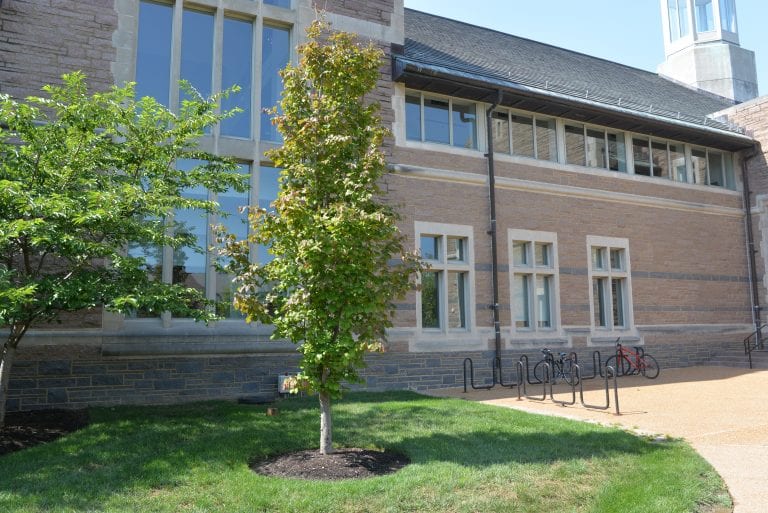
Persian Parrotia
Arbor Walk #1, Treekeeper ID #2642
Also known as the Persian ironwood, the Persian Parrotia is known for its exfoliating bark which is particularly noticeable in the winter. When young, its leaves are reddish purple, and as it matures they will become dark green in the summer and yellow, orange, and red in the fall.
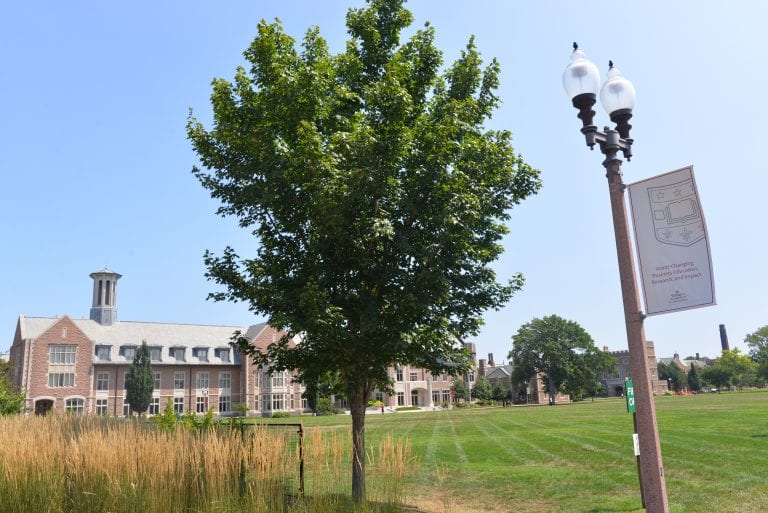
Miyabe Maple
Arbor walk #2, TreeKeeper ID #3153
This tree is native to Japan, although it has become endangered within its own native range. This cultivar was introduced at the Morton Arboretum in Illinois.
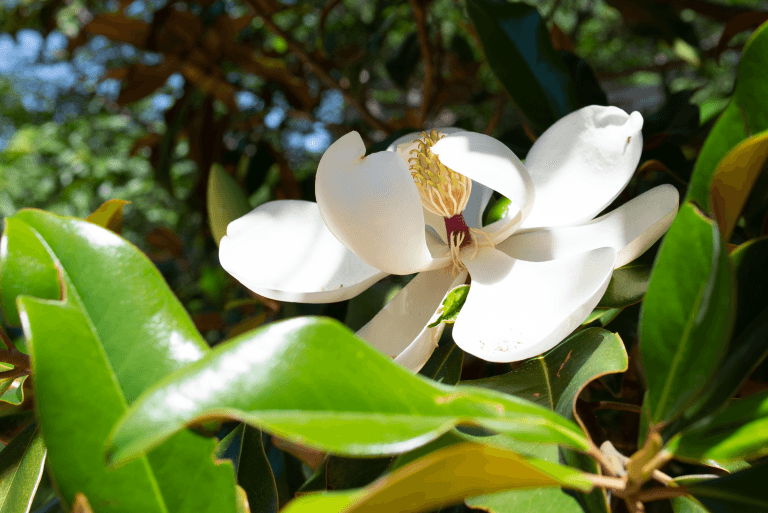
Southern Magnolia
Arbor Walk #3, TreeKeeper #2164
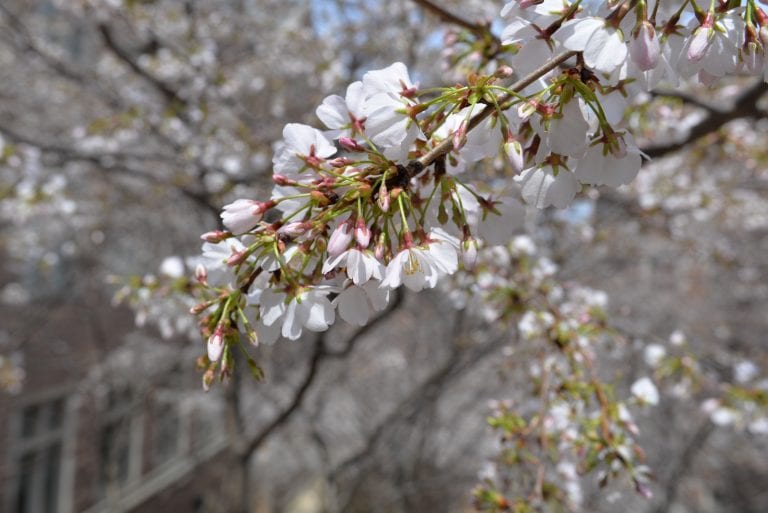
Yoshino Cherry
Arbor walk #4, Treekeeper ID #4302
The Yoshino Cherry is a beautiful tree with slightly fragrant, pinkish white flowers that appear in early spring. There are numerous Yoshino Cherry Trees that line the stairs by the Olin Law School that form an allée.
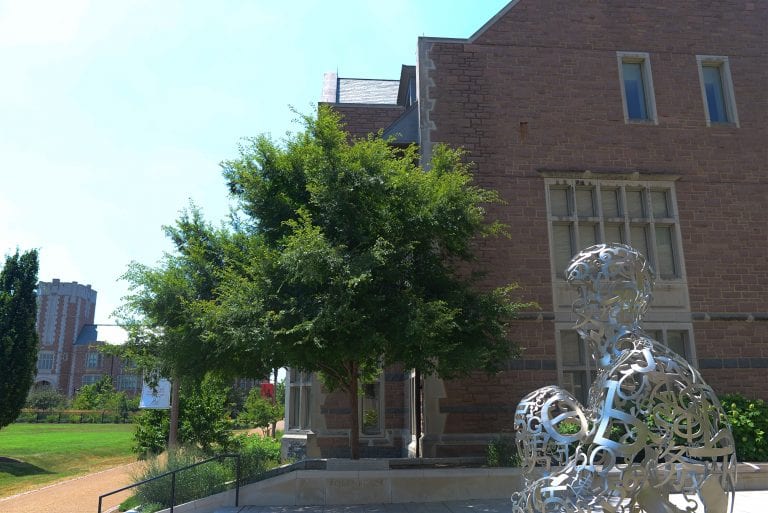
Lacebark Elm
Arbor walk #5, Treekeeper ID #3495
The Lacebark Elm is a large elm native to China that is known for its intricate bark and durable wood. It has strong resistance to the deadly Dutch Elm Disease, making it an ideal planting or hybridization target.
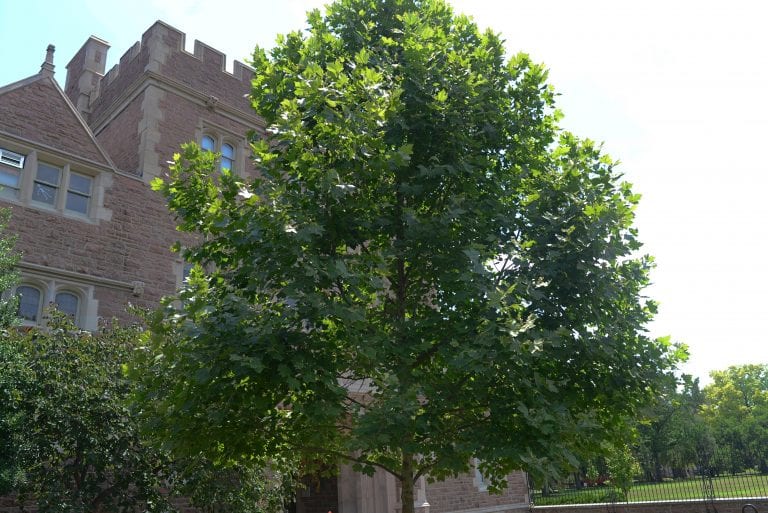
London Planetree
Arbor walk #6, Treekeeper ID #2200
The London Planetree is a hybrid of the Oriental Plane (Platanus orientalis) and American Sycamore (Platanus occidentalis), combining improved disease resistance with cold tolerance. The London Planetree is also extremely tolerant of pollution, and is even found to be an effective removal agent of air pollution particles.
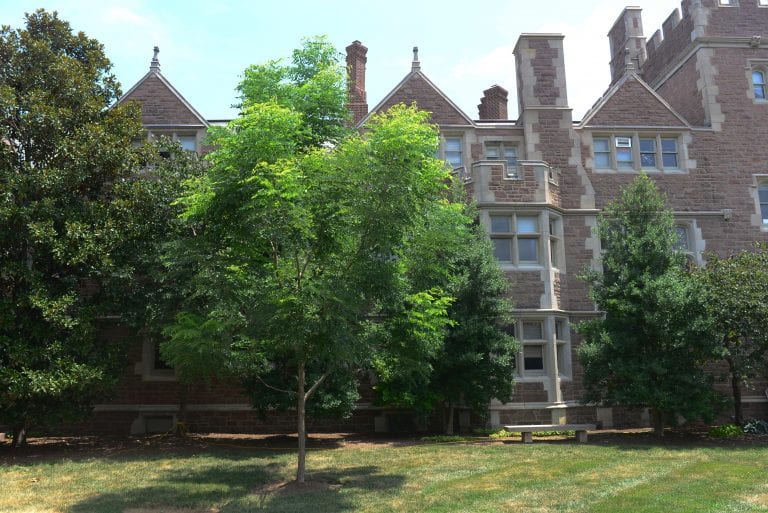
Kentucky Coffeetree
Arbor walk #7, Treekeeper ID #2253
This tree is a “seedless” variety of the native species. It is native to Missouri and the Midwest. Early settlers of Kentucky used the tree’s seeds as a coffee substitute, hence its common name.
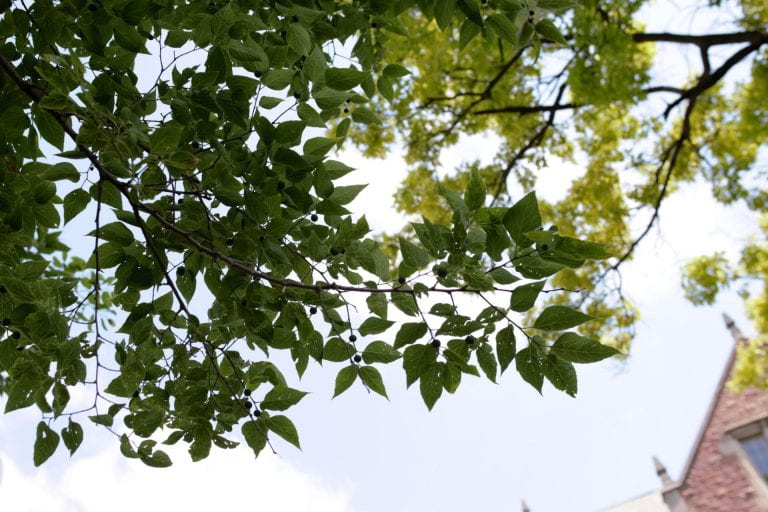
Common Hackberry
Arbor Walk #8, Treekeeper ID #6122
This native tree performs well in urban conditions and is easily identified by its distinctive corky bark. But be careful because there are other relatives that are native to Missouri that have very similar bark.
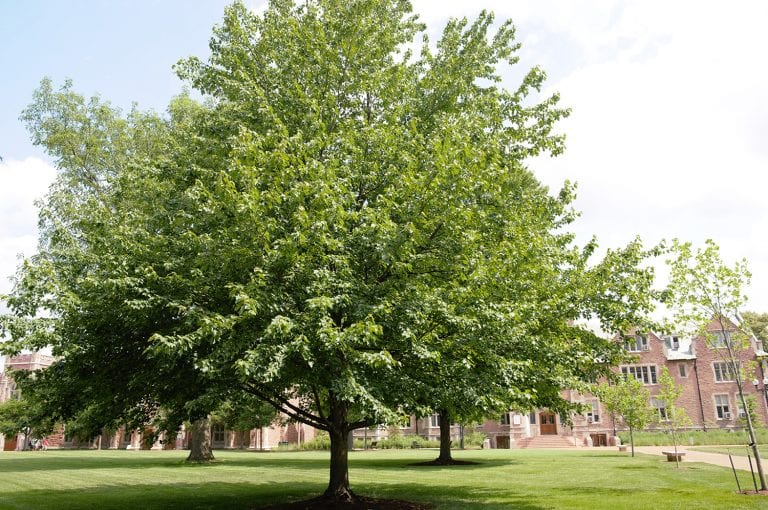
Red Maple
Arbor Walk #9, TreeKeeper ID #1875
This is a large, native, shade tree and its reddish fall color is one of its most dramatic features. The flowers, seeds, and twigs on the Red Maple also have red color spread throughout.
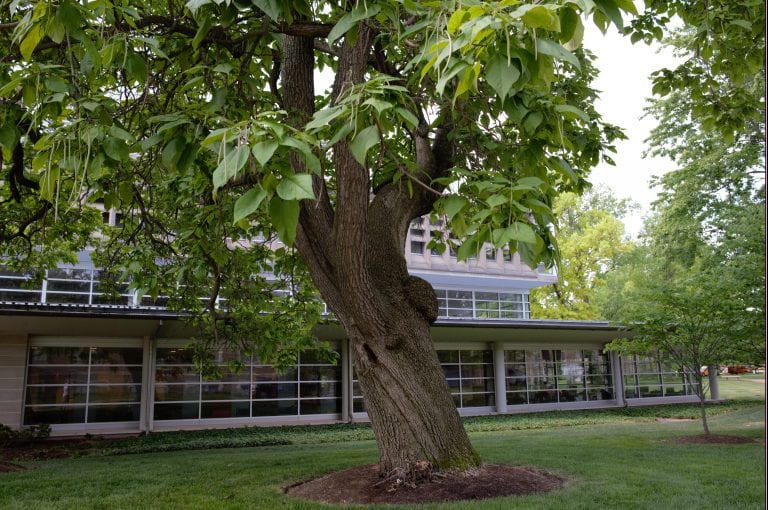
Northern Catalpa
Arbor Walk #10, TreeKeeper ID #1781
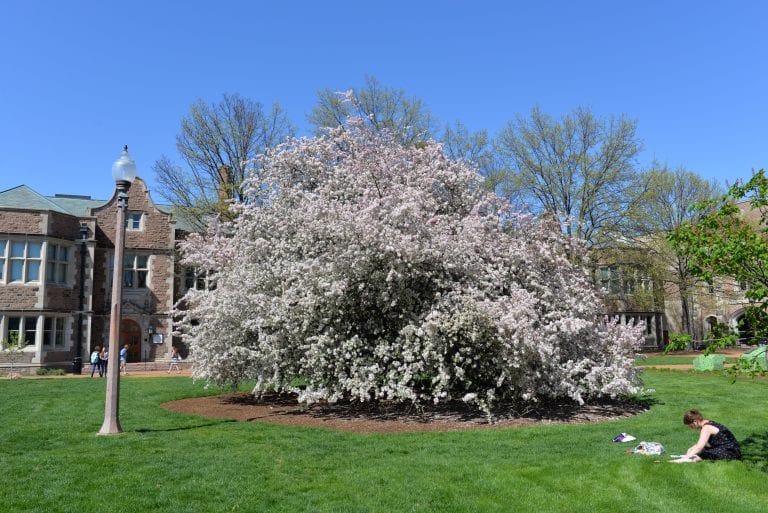
Japanese Flowering Crabapple
Arbor walk #11, Treekeeper ID #1607
This small flowering tree belongs to a family of trees that are popular for their profuse spring flowers. This tree also produces its namesake crabapples, which are edible except for the seed, yet very small. Arbor Walk #11 has a dome-like shape and students often study underneath the tree’s canopy in hotter months.
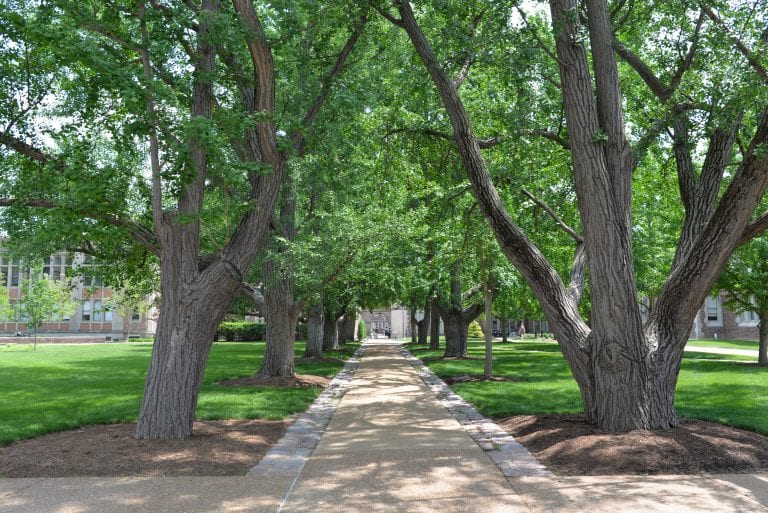
Ginkgo
Arbor walk #12, Treekeeper ID #1649
This tree’s unique fan shaped leaves turn brilliant golden yellow in fall. This adjacent group of Ginkgos forms a historic allée that was part of the original 1927 Cope and Stewardson Plan for the university campus.
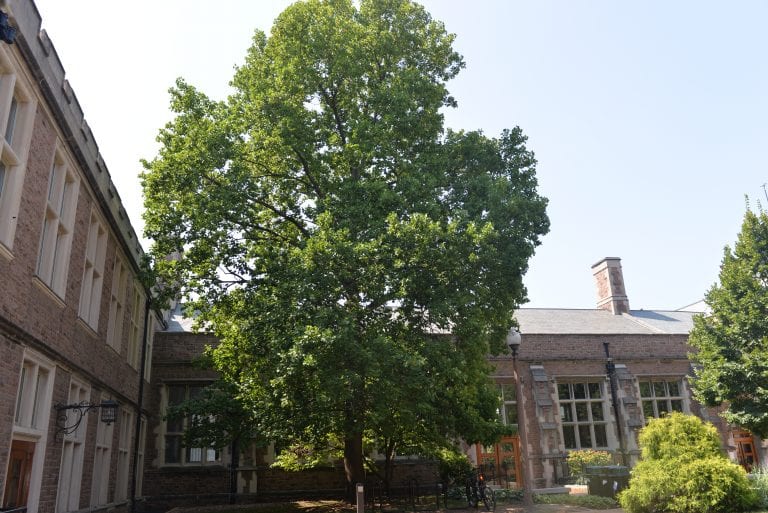
Tulip Poplar
Arbor Walk #13, Treekeeper ID #1888
This native tree’s common name comes from its flower that is shaped like a tulip. In 1991, WashU was given this tree as a seedling. It was grown from seed taken from the original Tulip Trees planted by George Washington in 1785 at his Mount Vernon home.
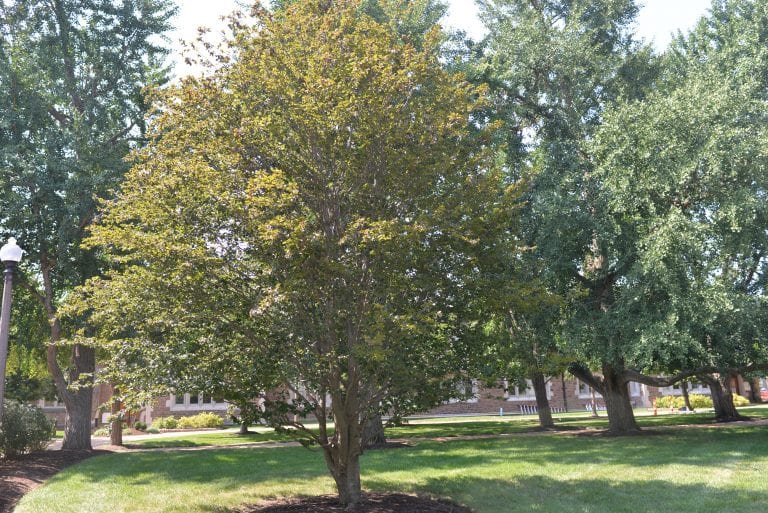
European Beech
Arbor walk #14, Treekeeper ID #1691
This beautiful non-native tree is adaptable to the Midwest. It has golden bronze leaves in the fall and its bark has a gray, elephant-hide appearance.
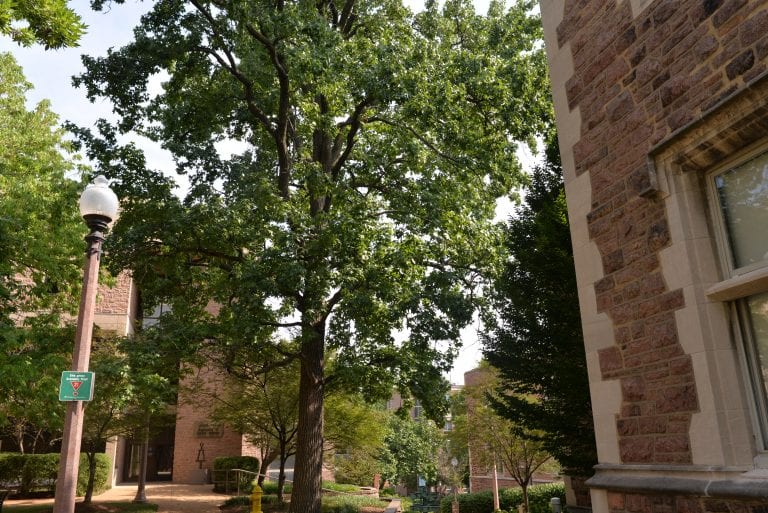
Sweetgum
Arbor Walk #15, Treekeeper ID #1439
This tree’s star shaped leaves provide great fall color. Its fruits are the spiky “gum balls” which can hang on the tree all winter.
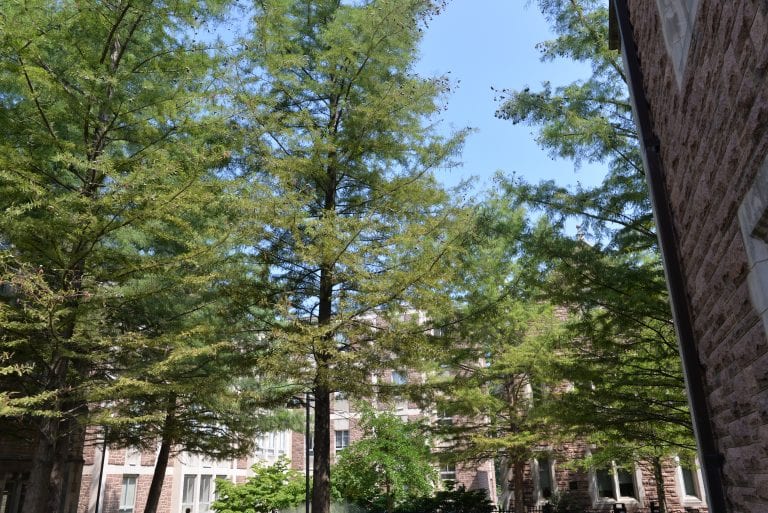
Bald Cypress
Arbor Walk #16, Treekeeper ID #1427
This tree is native to wetlands and swamps in the Midwest but is adaptable to urban conditions. Its needlelike foliage turns russet red and drops in the fall.
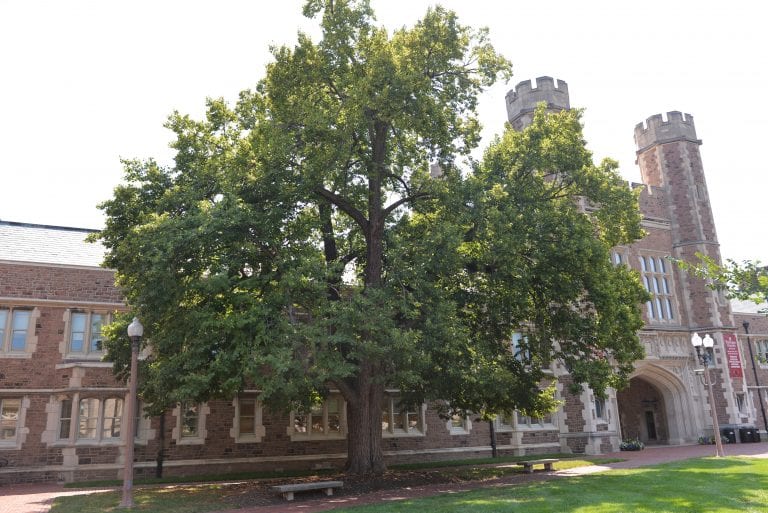
American Basswood (removed July 2023)
Arbor Walk #17, Treekeeper ID #1937
This is one of the oldest and largest trees on campus. It has large green leaves and small, sweetly scented flowers. Recently, efforts have been taken to preserve and continue on the genetic lineage of this tree whose history follows that of WashU’s Danforth Campus.
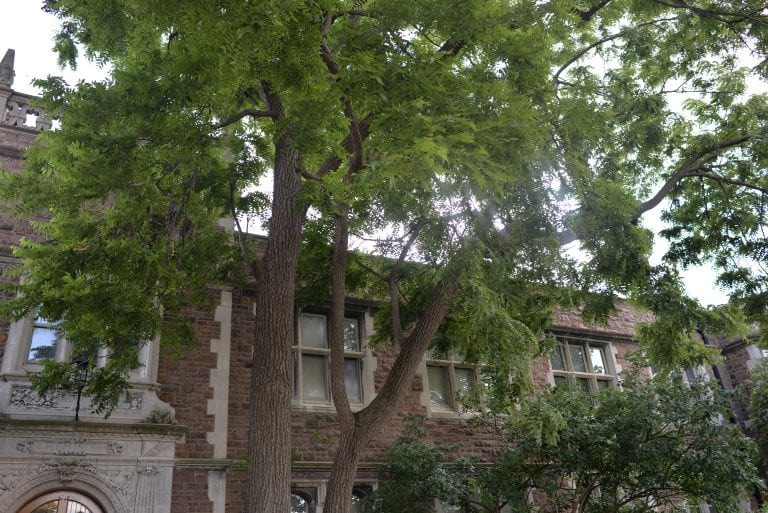
Black Walnut
Arbor Walk #18, Treekeeper ID #1386
This is a large native tree whose wood is used for woodworking in the furniture and cabinet industry.
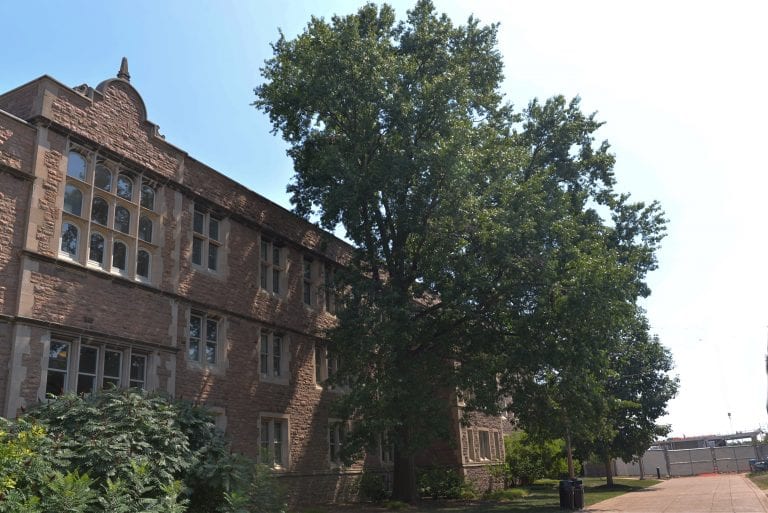
Pin Oak
Arbor walk #19, TreeKeeper ID #1810
The pin oak is a popular tree that is planted because of its quick growth and the dense shade it provides. It has a distinct form that is pyramidal during early maturity but turns more oval later in life.
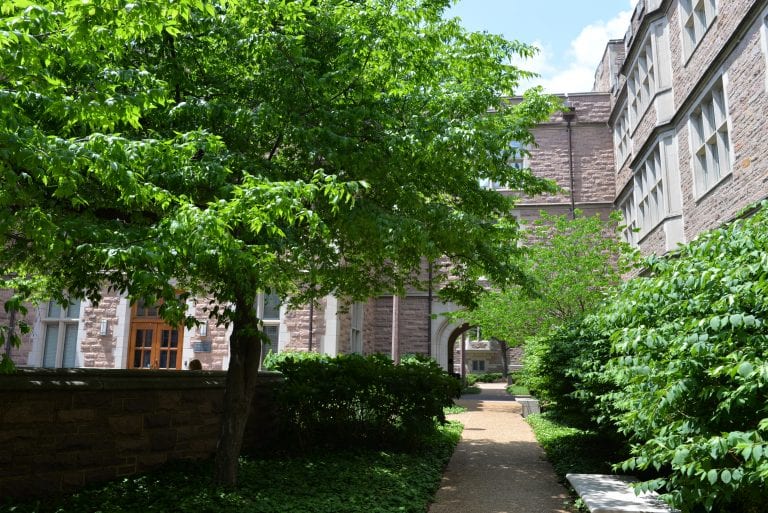
American Hornbeam
Arbor Walk #20, Treekeeper ID #1933
Native to the midwest, the American Hornbeam typically grows as an understory tree, in wetter areas. Its leaf is dark green, ovate, with doubly serrated edges.
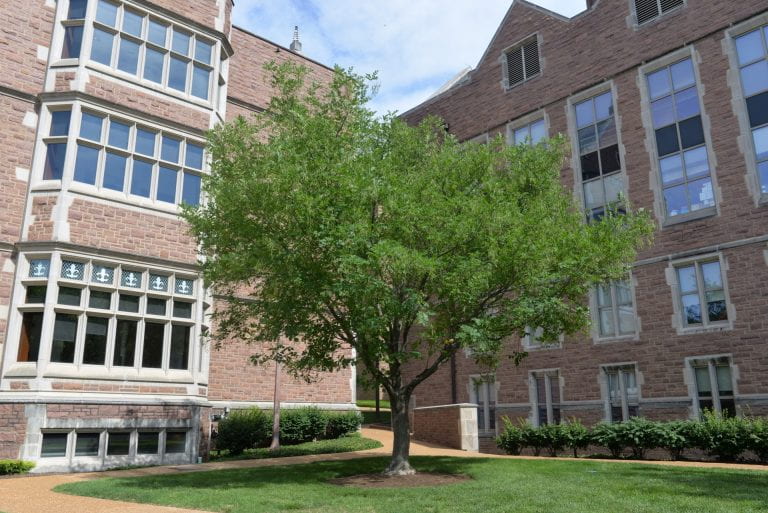
Yellowwood
Arbor Walk #21, Treekeeper ID #1882
This medium sized shade tree has panicles of sweet smelling flowers in early summer and brilliant yellow leaves in the fall.
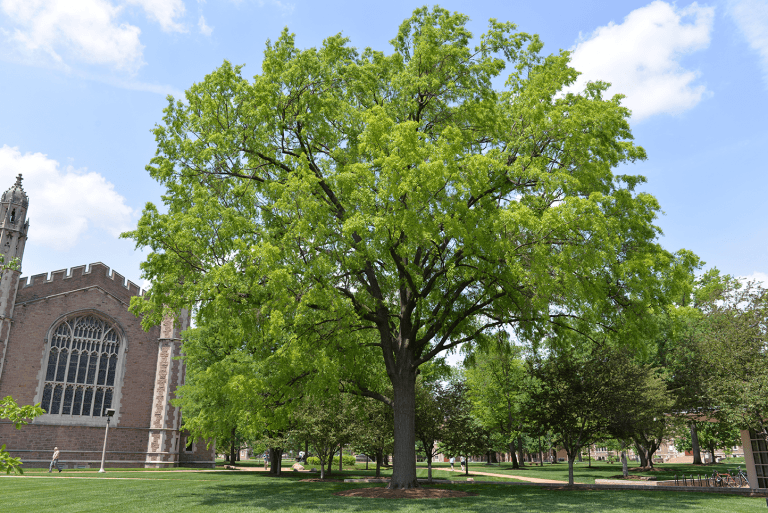
Willow Oak
Arbor Walk #22, Treekeeper ID #1513
This large native tree has a simple, small leaf, and a finer texture than most oak trees. It is considered a medium to large oak, can grow over 100 feet tall, and is native to the Southeastern portion of the United States, including Missouri.
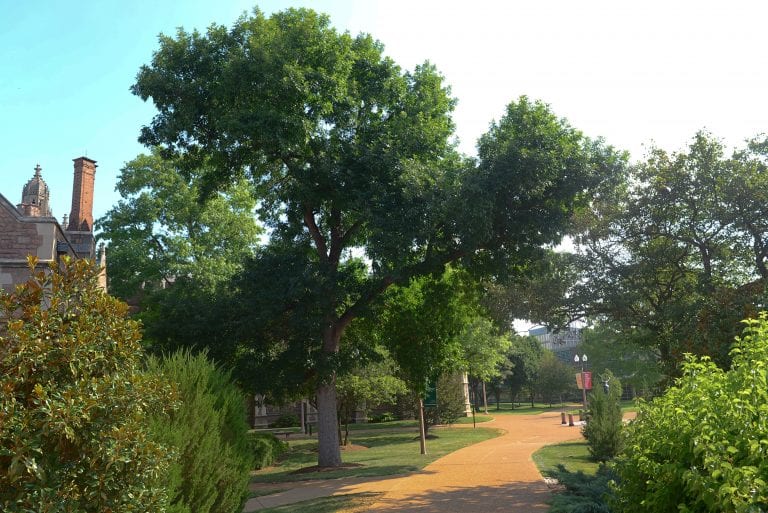
Green Ash
Arbor walk #23, Treekeeper ID #2384
This native tree species is threatened by the Emerald Ash Borer. Since its discovery in 2002, the Borer, a native of Asia, has killed hundreds of millions of ash trees in North America.
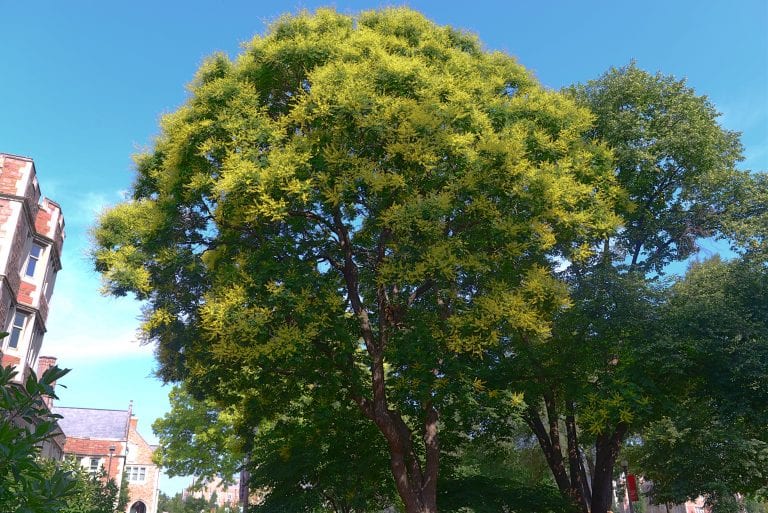
Golden Raintree
Arbor walk #24, Treekeeper ID #3978
This tree’s unique foliage, summer blooming yellow flowers, and lantern-like fruit make it one of the most interesting trees in the campus forest.
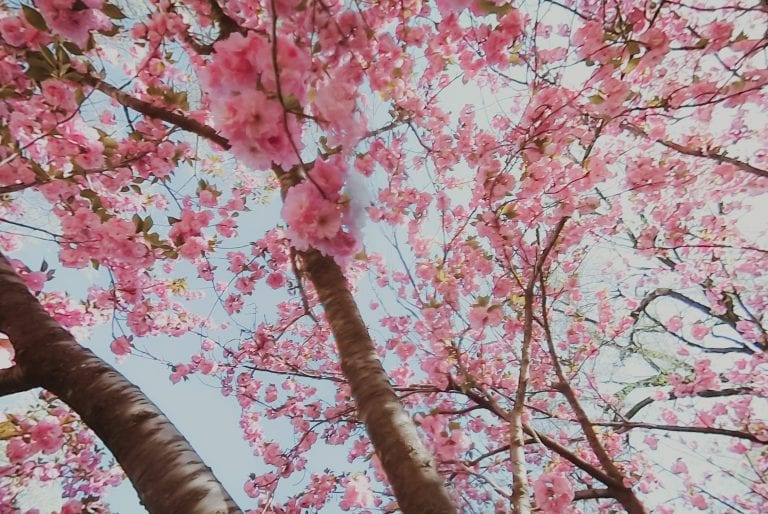
Japanese Flowering Cherry
Arbor walk #25, Treekeeper ID #4120
The Kwanzan variety is probably the hardiest of the double flowering cherry trees. Its new leaves are bronze colored and its fall color is a bronzy-orange. It blooms pink in mid spring and is the last of the cherry trees to bloom.
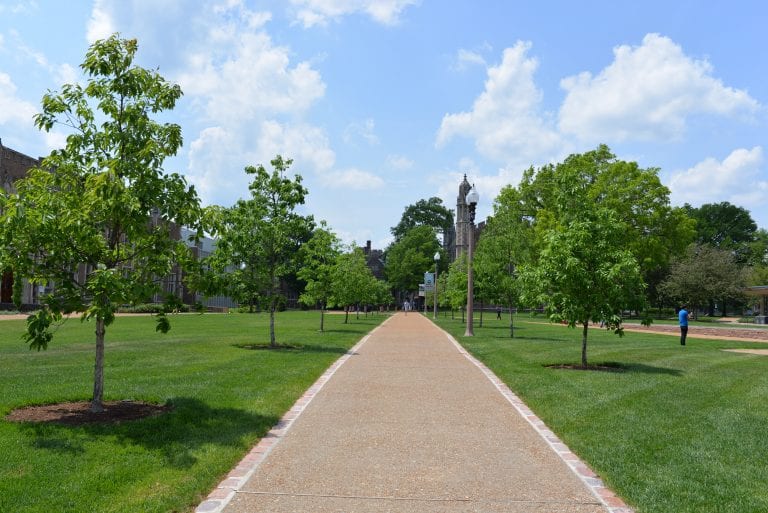
Chinkapin Oak
Arbor Walk #26, Treekeeper ID #1345
Native to the Midwest, the Chinkapin Oak can be easily recognized due to its small, toothed leaves. Unlike most oaks, the Chinkapin has unusually flaky and fissured bark.
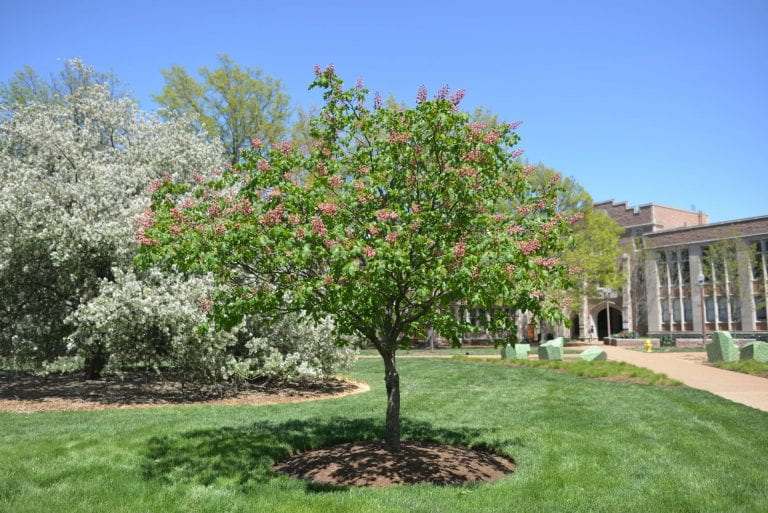
Red Horsechestnut
Arbor Walk #27, TreeKeeper ID #1622
The Red Horsechestnut is a hybrid between the European Aesculus hippocastanum (Horsechestnut) and the North American A. pavia (Red Buckeye). This small deciduous tree grows on average to medium moist well drained soil, in full to part sun.
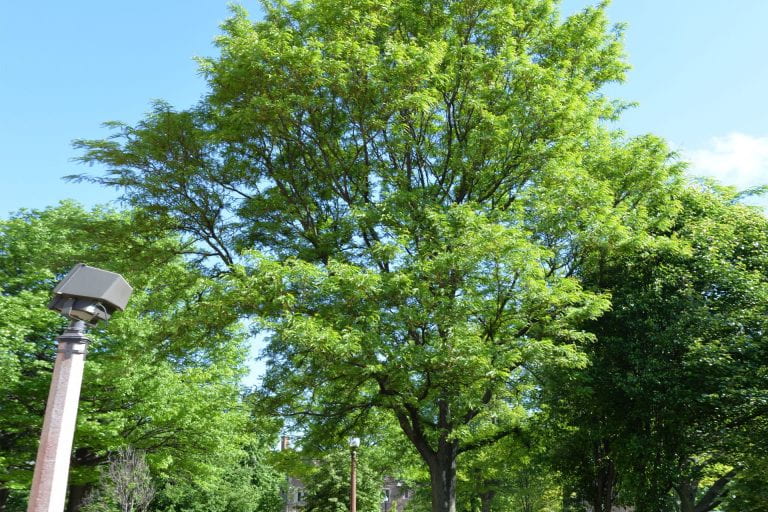
Common Thornless Honeylocust
Arbor Walk #28, Treekeeper ID #1610
This is a native plant, but if found in nature, its bark would likely be covered in long, sharp thorns. Arborists tend to plant this natural, thornless variant of the tree to allow people to see its beauty without obtaining injuries.
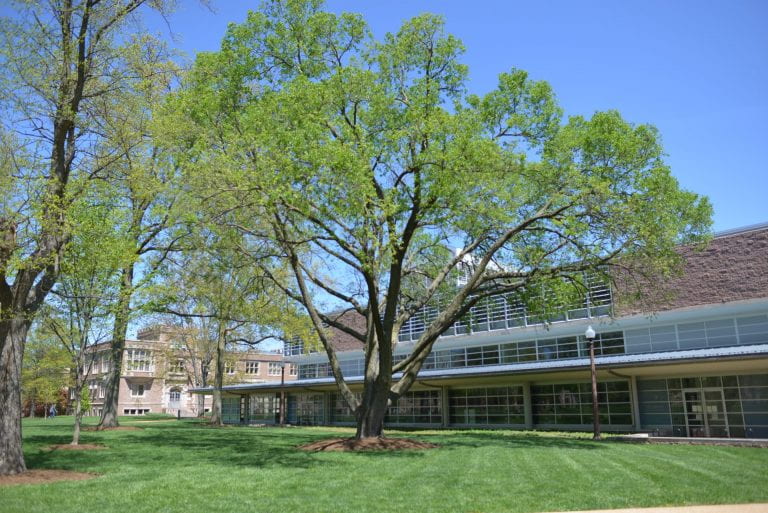
Sugarberry
Arbor Walk #29, Treekeeper ID #1658
This lovely mature tree has shaded the west side of Olin Library for generations of students but sadly came down in a storm in July 2023. The Sugarberry is known for its distinctive corky bark and edible berries.
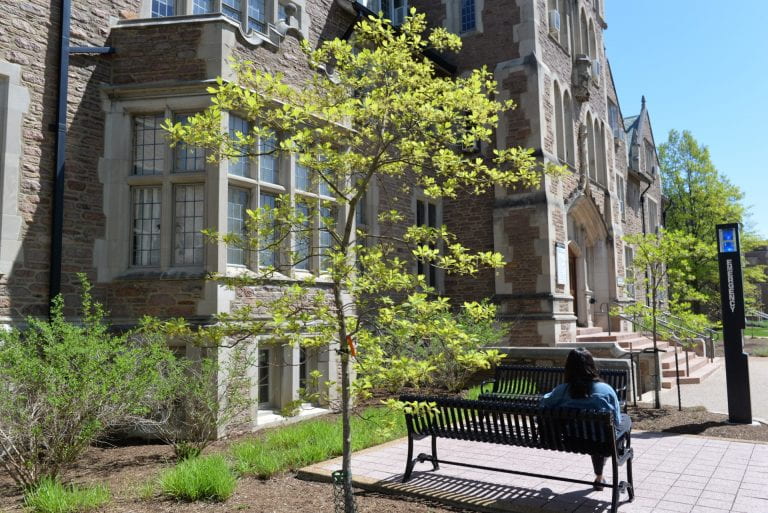
Sassafras
Arbor Walk #30, TreeKeeper ID #1531
This Missouri native tree is capable of producing clones from its sprawling root system, allowing it to create genetically identical colonies. It has leaves that emit a spicy fragrance when crushed.
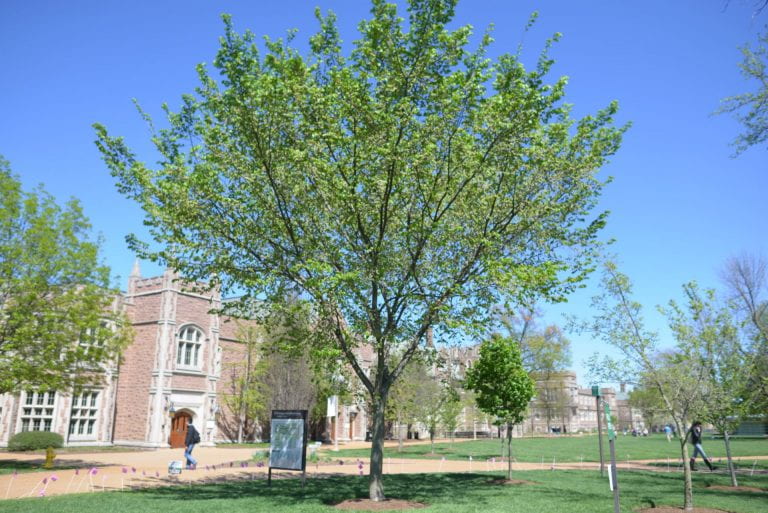
American Elm
Arbor Walk #31, Treekeeper ID #2408
The American Elm is native to much of Eastern North America and grows in low, moist areas and along streams across the state of Missouri.
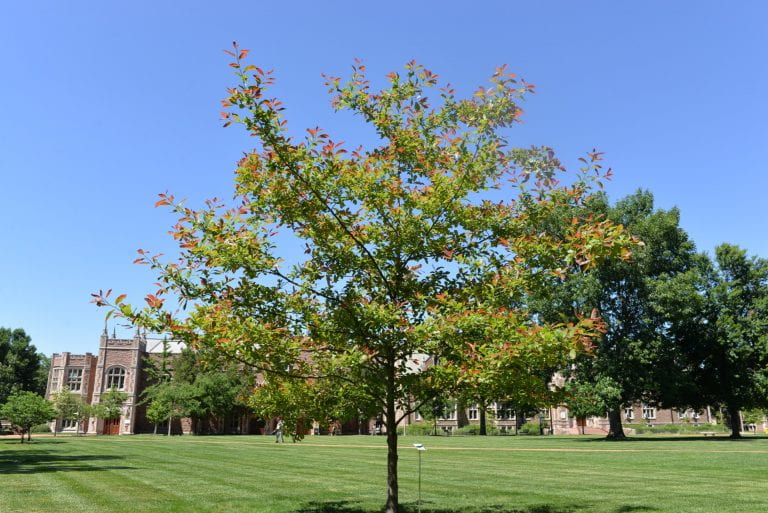
Black Gum
Arbor Walk #32, Treekeeper ID #2247
The Black Gum, also called Tupelo, is a Missouri native and flexible mid-western species capable of growing in both standing water and rocky slopes.
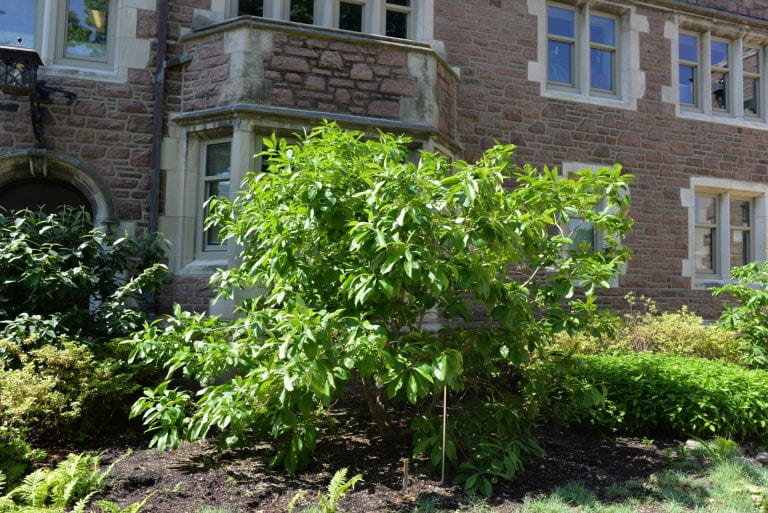
Fringe Tree
Arbor walk #33, Treekeeper ID #5592
This tree is a Missouri native which grows easily in fertile, moist soil. In the wild, it typically grows at forest transition boundaries, along stream banks, or in the margins of limestone glades.
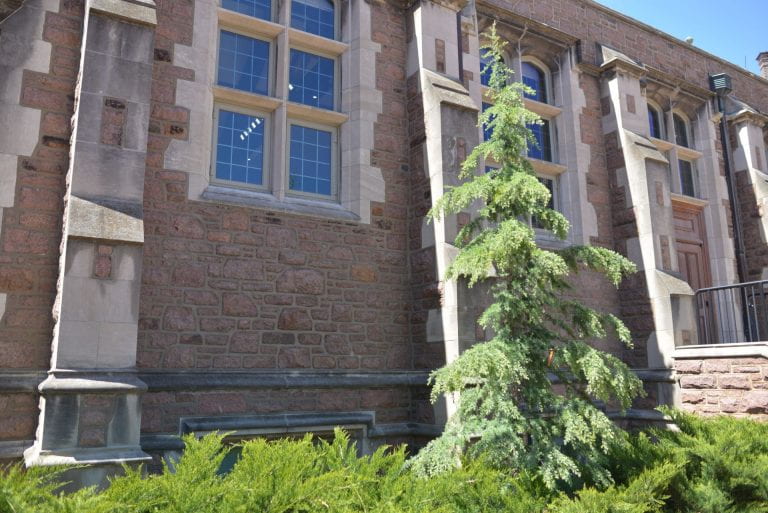
Deodar Cedar
Arbor Walk #34, Treekeeper ID #3817
This tree species is originally native to the Himalayas range, but due to its high tolerance to heat for a true cedar, it is able to grow in certain specific conditions in the United States such as the St. Louis area.
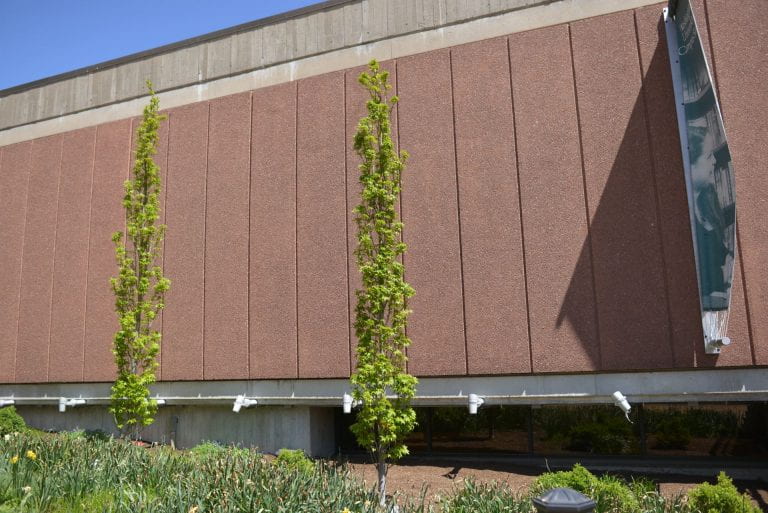
Sweetgum
Arbor walk #35, Treekeeper #2995
This low-maintenance deciduous shade tree is native to much of the Eastern US and in Southeast Missouri, usually in low, wet, woodland areas or along stream beds. It has a variety of human-use applications such as chewing gum, incense, perfume, and medicine.
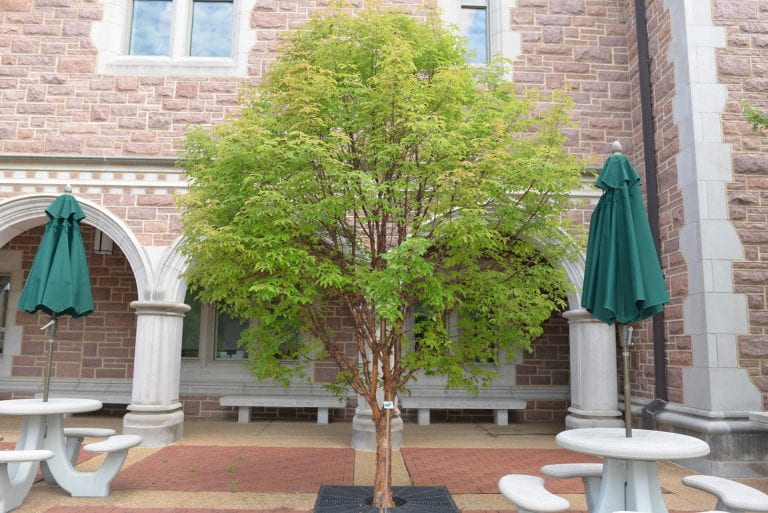
Paper Bark Maple
Arbor walk #36, TreeKeeper ID #3160
A type of maple originally native to the mixed forests of Central China, this species was introduced to the West through England in 1899 and transplanted to America soon after.
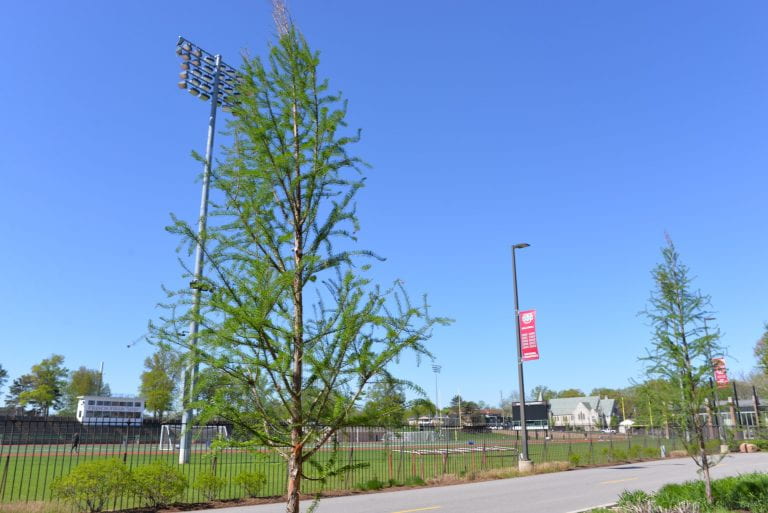
Bald Cypress
Arbor Walk #37, Treekeeper ID #2507
The Bald Cypress is the state tree of Louisiana. Despite its resemblance to a needled evergreen tree in the summer, it is actually deciduous. The ‘Mickelson’ is a cultivar of the Bald Cypress, and has a narrower shape and denser foliage than the native species.
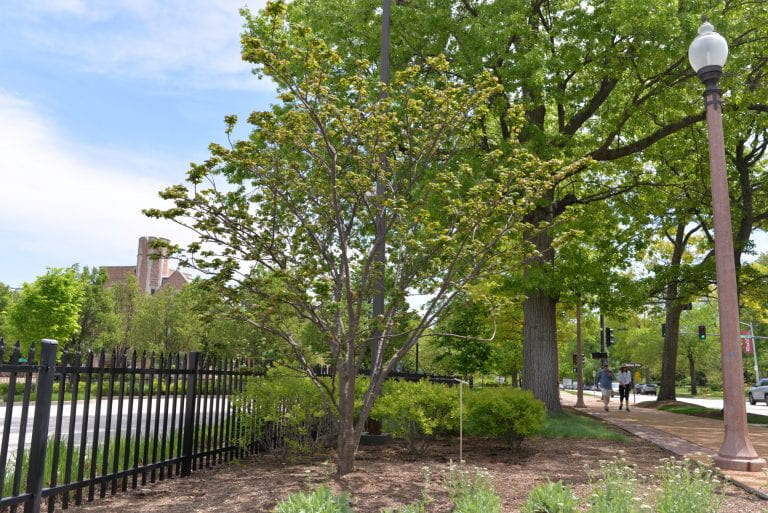
Eastern Redbud
Arbor Walk #38, TreeKeeper ID #3141
This deciduous understory tree is the state tree of Oklahoma and is native to Missouri and much of the Eastern and Central US. It grows in medium moisture, medium fertility soils.
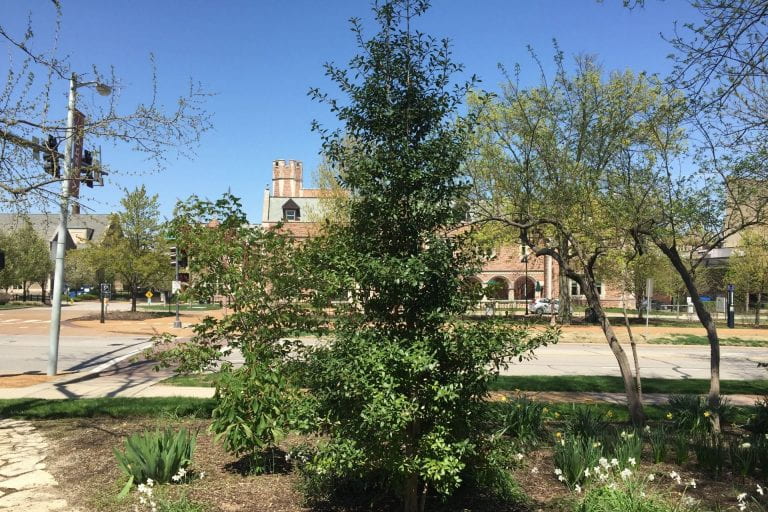
Foster Holly
Arbor walk #39, Treekeeper ID #4373
A naturally occurring hybrid species of American Holly and Dahoon Holly, it was found growing in the wild in Florida in 1924. This is a broadleaf evergreen tree of small to medium stature that prefers well-drained, slightly acidic soil and dislikes extreme hot and cold temperatures.
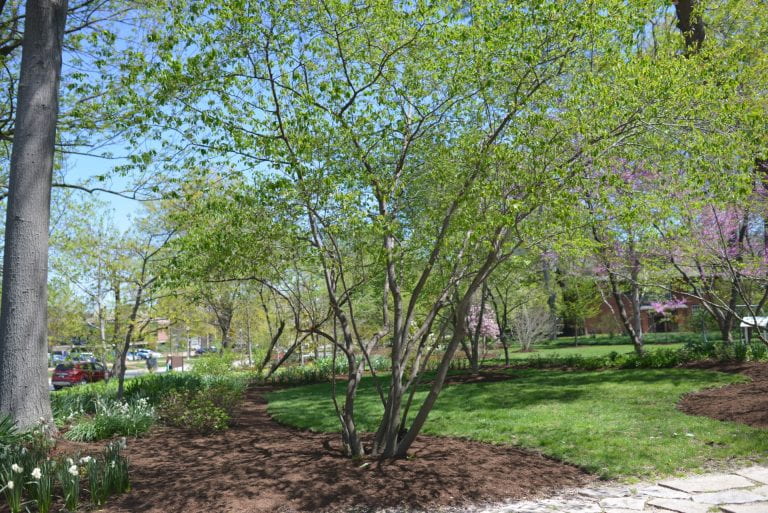
Downy Serviceberry
Arbor Walk #40, Treekeeper ID #4578
This Missouri native tree offers edible, berry-like fruit that changes color throughout the seasons. The competition for the fruit is stiff because they are a favorite of many bird species.
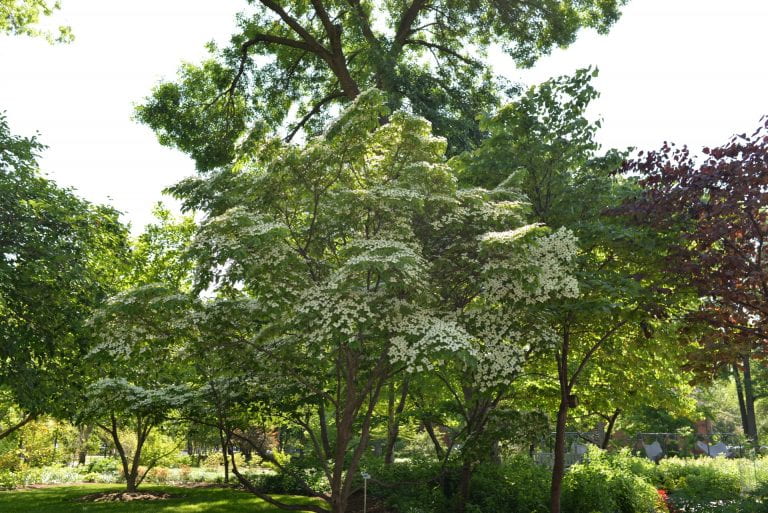
Kousa Dogwood
Arbor walk #41, Treekeeper ID #4568
This tree, native to Asia, is known for its four-petaled white flowers in June and its reddish-purple color in Fall.
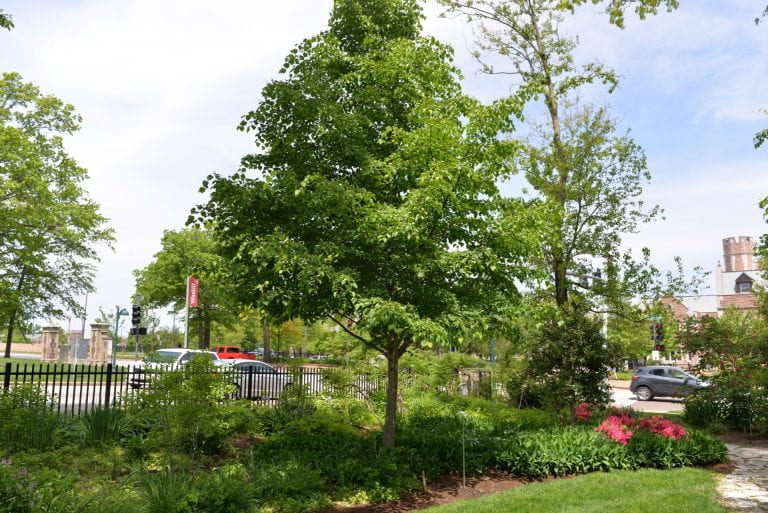
Littleleaf Linden
Arbor walk #42, Treekeeper ID #4386
The Little-Leaf Linden is uniquely adept at withstanding polluted environments, and is therefore a great shade tree for urban settings. It is a native to Europe and exists in the wild only in protected pockets of land, where it provides ecological benefits for moths and pollinators.
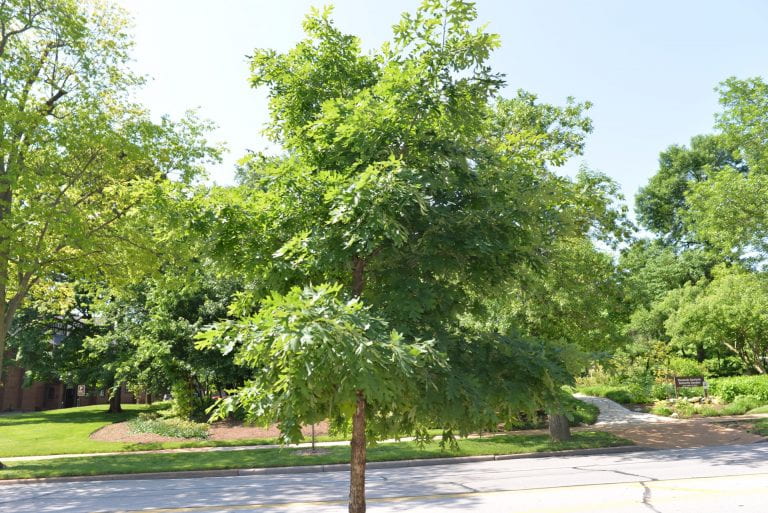
White Oak
Arbor Walk #43, Treekeeper ID #2690
The White Oak is one of the most ubiquitous trees in all of the eastern United States. The White Oak is the state tree of Illinois, Connecticut, and Maryland, and numerous trees along the East Coast have stood in towns or cities since before European occupation.
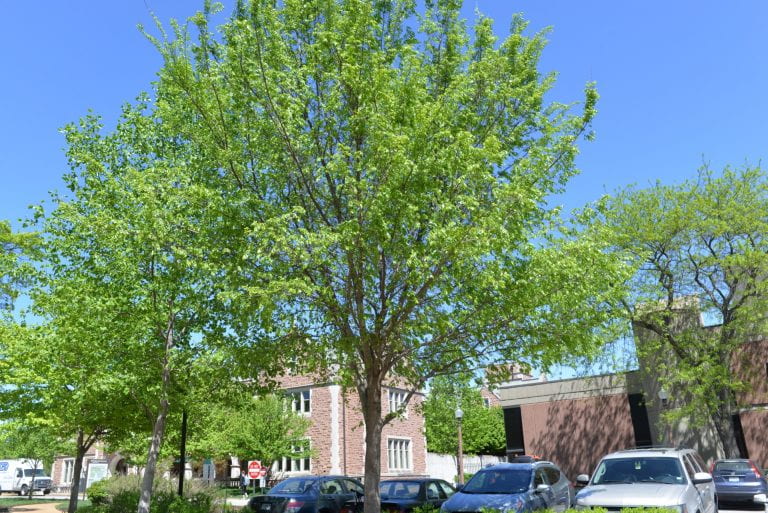
Frontier (Hybrid) Elm
Arbor walk #44, Treekeeper ID #2942
This medium-sized tree is hardy and tolerant to drought, heat, and poor soil which make it well suited as a replacement for the many elms used residential landscapes and city streets.
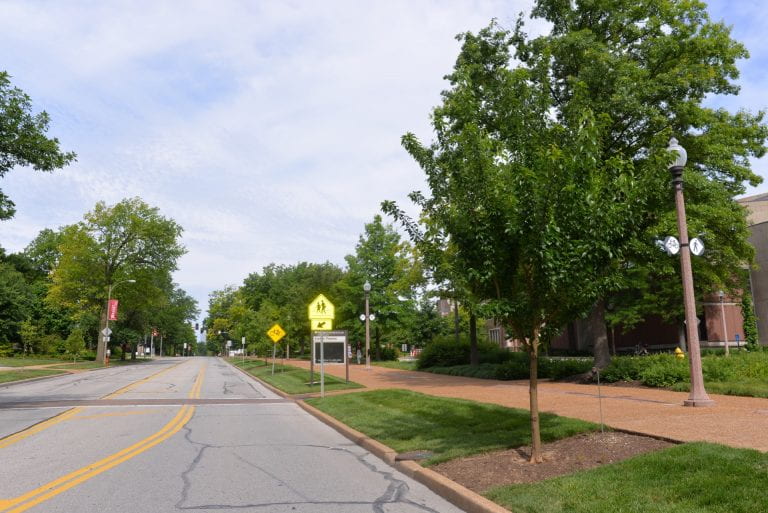
Osage Orange
Arbor walk #45, TreeKeeper ID #2621
This medium-sized tree has a short trunk and rounded crown. it produces large fruit (8-15 cm in diameter) which is roughly spherical, bumpy, and turns bright yellow-green in the fall.
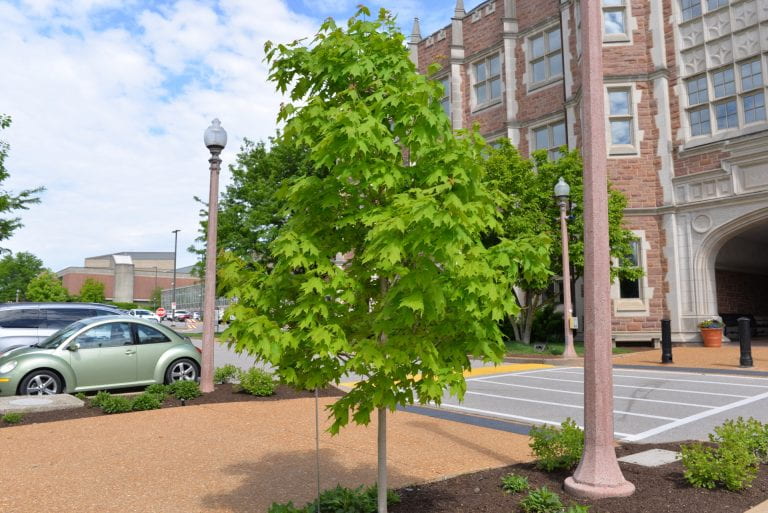
Sugar Maple
Arbor Walk #46, Treekeeper ID #2067
This iconic tree is native to much of Eastern North America, where it is a dominant component of hardwood forests from Canada to Missouri.
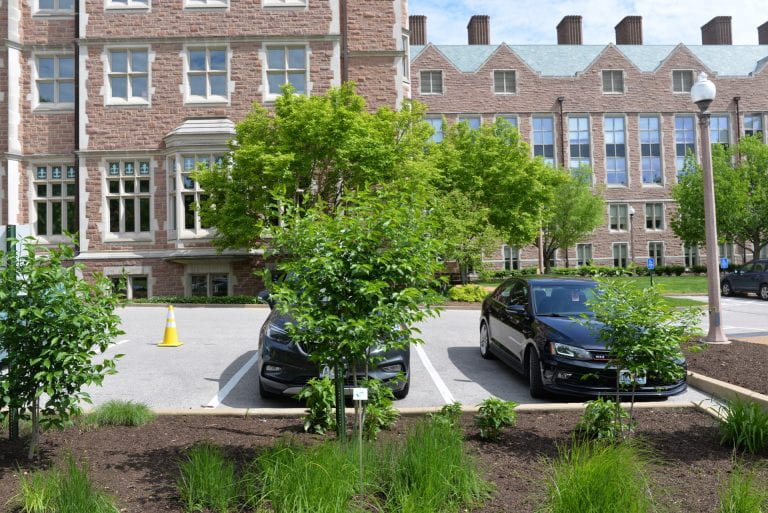
Eastern Wahoo
Arbor Walk #47, Treekeeper ID #6770
This small tree is a Missouri and Chicago-region native offering attractive bright red fruit and beautiful color in the fall.
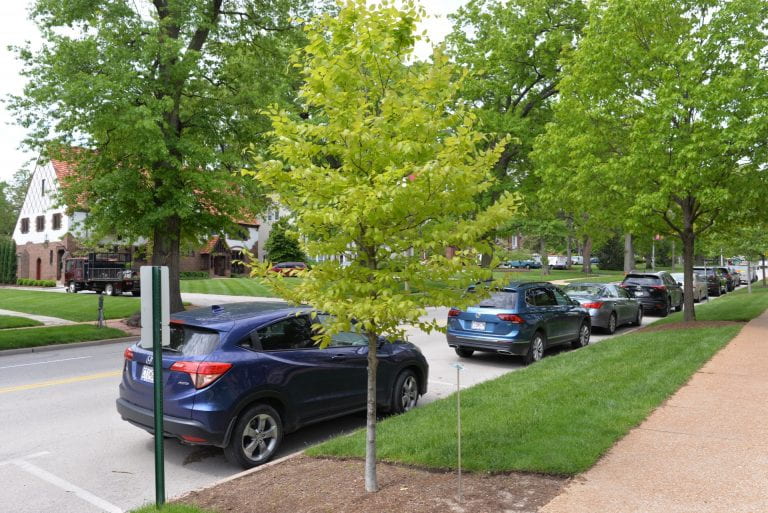
American Beech
Arbor Walk #48, Treekeeper ID #1979
This tree has dark green leaves which turn bronze in the fall. Its flowers are yellowish-green, and the female flowers yield edible beechnuts which ripen in the fall.
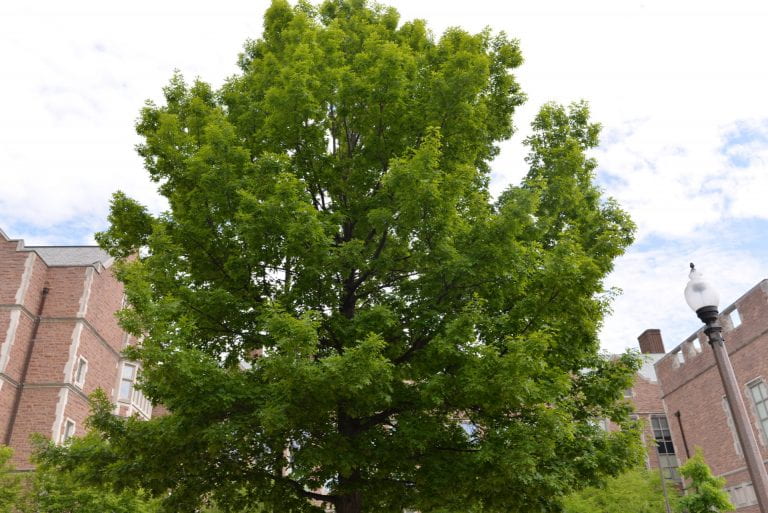
Scarlet Oak
Arbor walk #49, TreeKeeper ID #1925
Often used as a shade tree in lawns and along streets because it grows to a large size. It is native to southeastern Missouri.
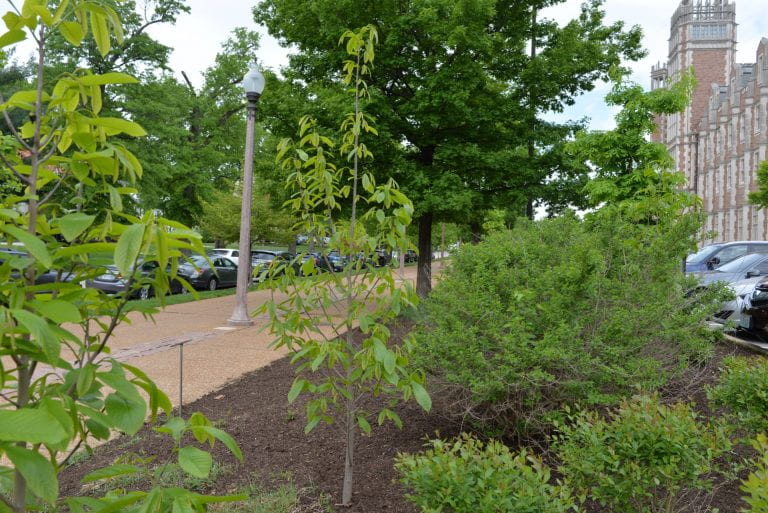
Pawpaw
Arbor walk #50, TreeKeeper ID #1801
This Missouri native has dark purple flowers in the spring, elongated edible fruit in the summer, and a yellow to yellow-green fall color which all add to the appeal of this small understory tree.
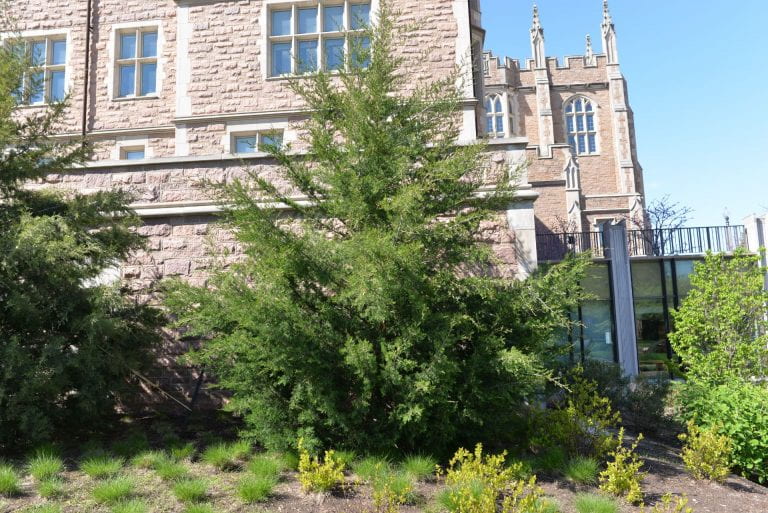
Eastern Red Cedar
Arbor Walk #51, Treekeeper ID #1648
This tree is native to Eastern North America; In Missouri, it grows in a variety of habitats across the state and is tolerant of a wide range of soil conditions.
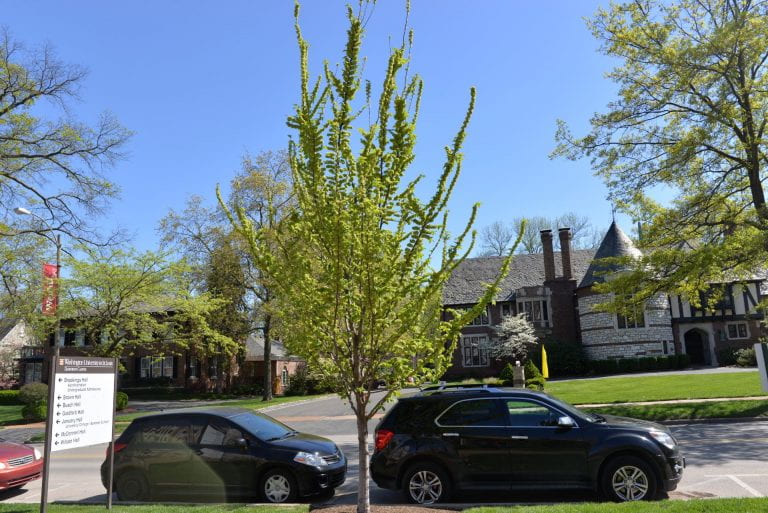
Emerald Sunshine Elm
Arbor Walk #52, Treekeeper ID #1676
This Asian hybrid Elm is a relatively small cultivar growing 35 feet high and 25 feet wide. It has glossy green leaves which turn yellow in the fall.
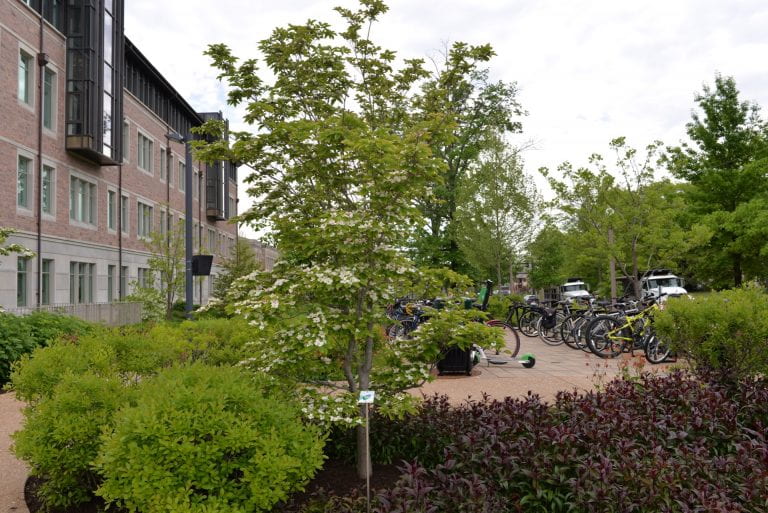
Flowering Dogwood
Arbor walk #53, Treekeeper ID #1410
Often claimed as the most beautiful of North America’s native flowering trees, the Flowering Dogwood is the state tree of both Missouri and Virginia. Its early-spring blooms of showy white petals surrounding tiny clusters of yellow dogwood flowers are among the tree’s most dramatic characteristics.
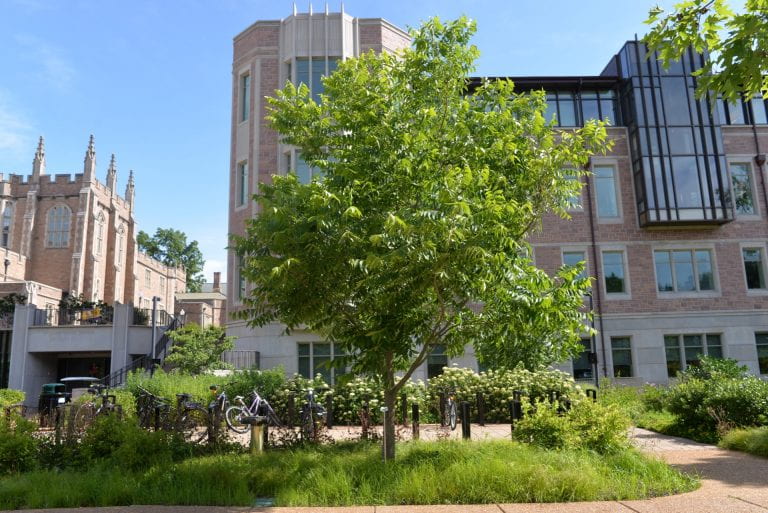
Pecan
Arbor walk #54, TreeKeeper ID #1424
This Missouri native tree is predominantly found in the Mississippi River Valley, and in the American South where it is cultivated as an important commercial nut crop.
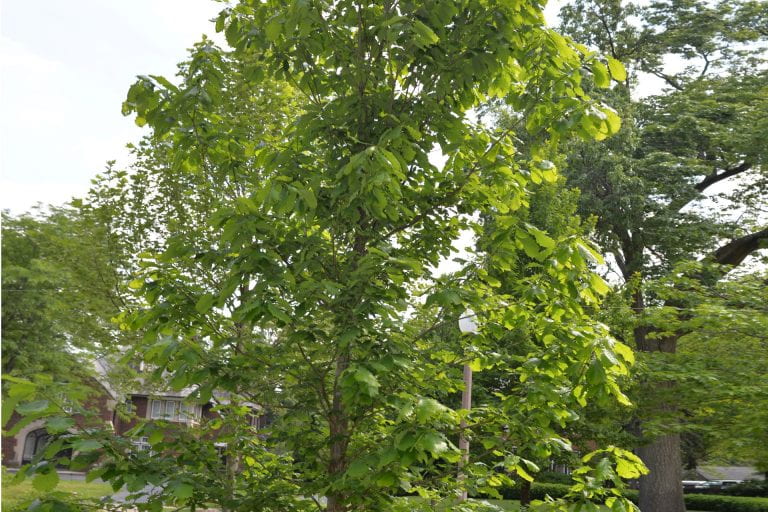
Swamp Chestnut Oak
Arbor walk #55, Treekeeper ID #7212
This shade tree is a Missouri native to floodplains. It produces acorns that, unlike most, can be eaten straight from the tree without needing to be boiled.

Overcup Oak
Arbor Walk #56, TreeKeeper ID #2039
Though adaptable to most soils, this Missouri native tree is particularly prevalent in lowlands, floodplains, swamps and bayous in the Southeastern US and in the Mississippi River Valley.
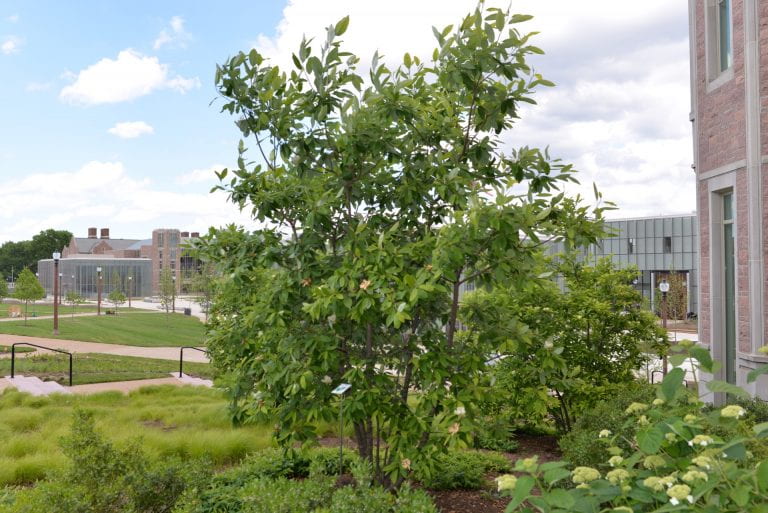
Sweetbay Magnolia
Arbor walk #57, Treekeeper ID #2063
Native to the Atlantic coast of the United States, the Sweetbay Magnolia MOONGLOW features creamy white flowers which bloom late spring and into summer, and are known for their sweet ‘lemony’ scent.
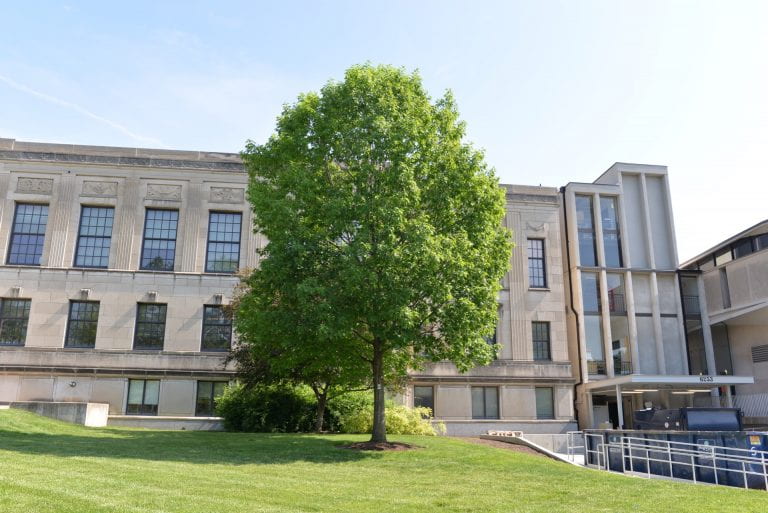
Northern Red Oak
Arbor Walk #58, TreeKeeper ID #1566
This Midwest native’s beautiful dense crown provides good shade, and along with its ability to tolerate air pollution and drought, has made it a landscaping favorite.
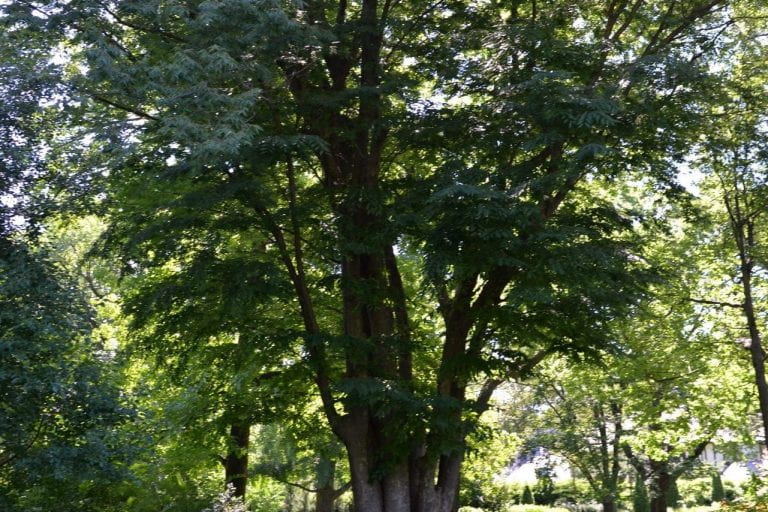
Japanese Zelkova
Arbor walk #59, Treekeeper ID #5340
A member of the Elm family which has been promoted as a replacement to American Elms because of its high degree of resistance to Dutch Elm Disease.
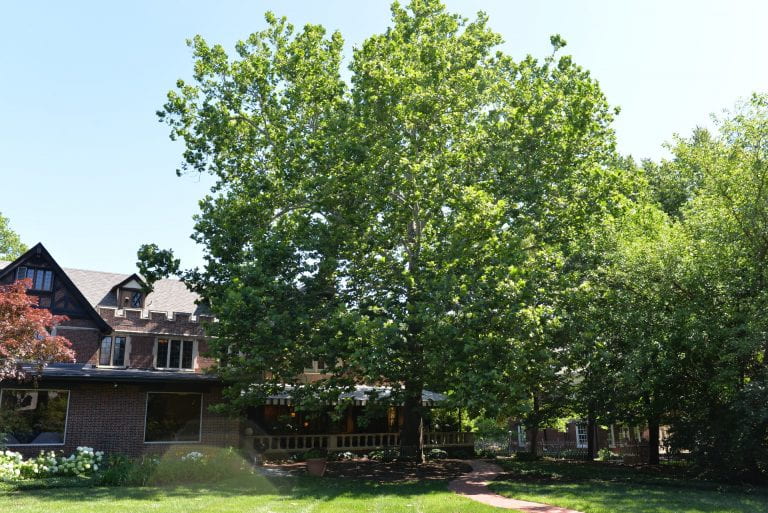
American Sycamore
Arbor Walk #60, Treekeeper ID #5449
The Sycamore is regarded as one of the largest trees native to eastern North America, and was historically prized by Native Americans for the construction of dugout canoes. Ecologically, they are early colonizers to newly available habitat, and support animal shelters as they mature.
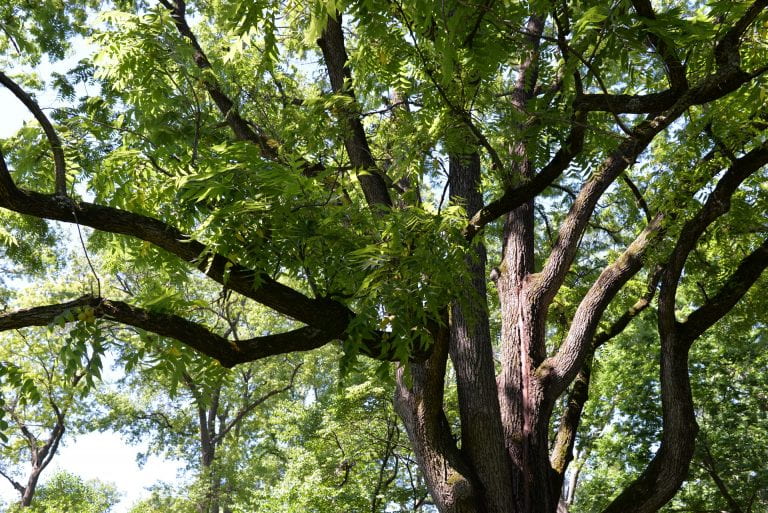
Black Walnut (Deaccessioned)
Arbor Walk #61, Treekeeper ID #5016
This is a large deciduous tree common to woodlands in the eastern United States from Massachusetts to Texas. It is natively found in rich woods and fertile river valleys across the state of Missouri.

American Arborvitae
Arbor Walk #62, Treekeeper ID #4666
The American Arborvitae is most prevalent in eastern and central Canada, and found in Northern Illinois, Ohio, and New York as well as scattered populations further south. St. Louis is near the southern end of the tree’s range, and it benefits from being in a slightly shadier location than they would prefer in their northern ranges.
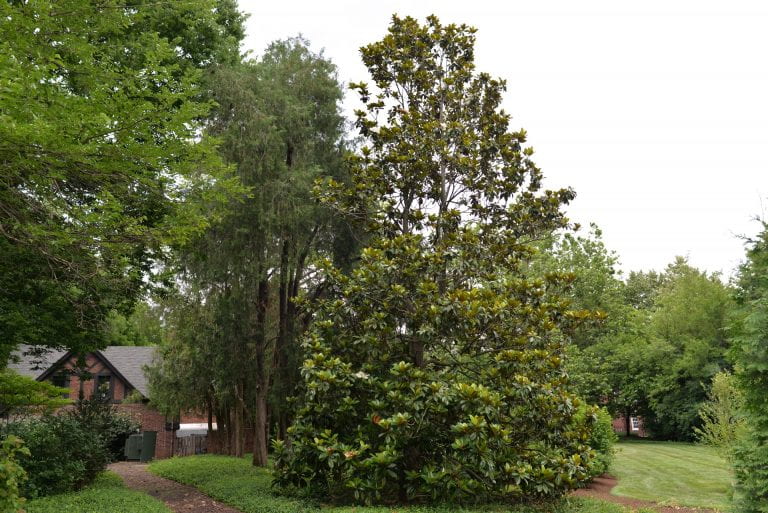
Southern Magnolia
Arbor Walk #63, TreeKeeper ID #4685
The Southern Magnolia, known for its fragrant late-springtime flowers, is one of the most characteristic native trees of the American South. The tree’s most distinctive feature is its leaves—glossy dark green on top and a soft pale green below.
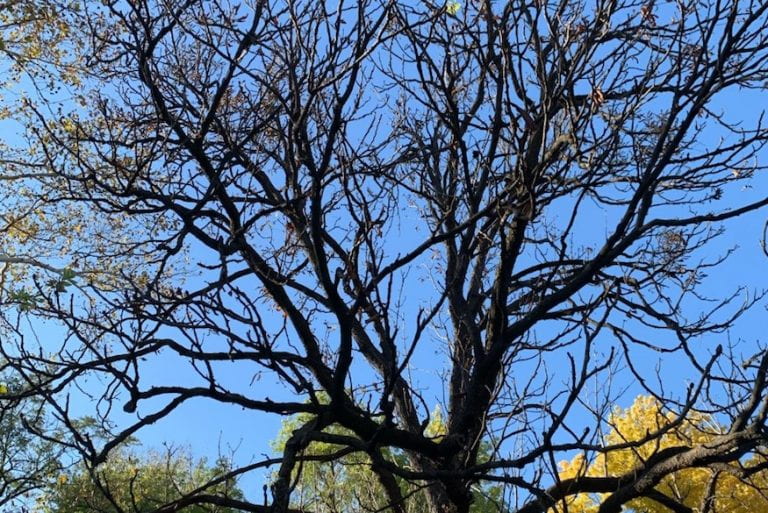
Common Horse Chestnut
Arbor Walk #64, Treekeeper ID #5490
Despite being widely planted as an easy-to-grow shade tree for streets and landscapes throughout the Midwest, the Common Horse Chestnut is originally native to the Balkan region of Europe. The tree features showy white flowers in spring which in summer transition into fruit, consisting of one or two seeds encased in a spiny husk.
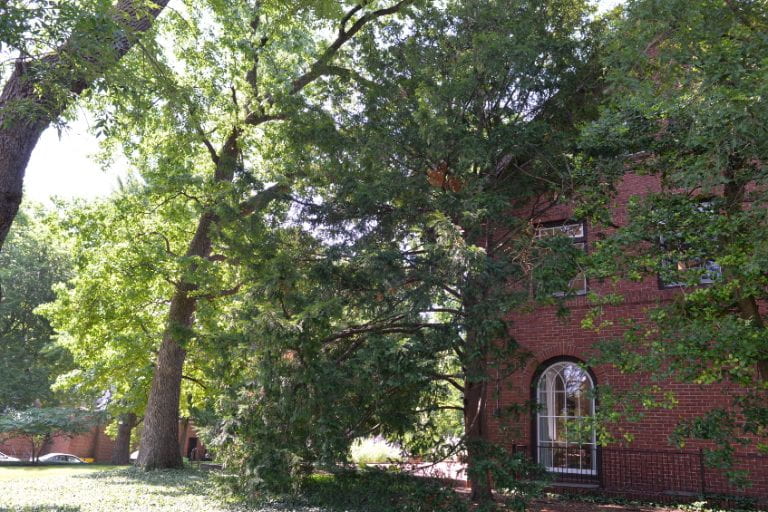
English Yew
Arbor walk #65, Treekeeper ID #5329
Though associated with England, this tree is actually native to all of Europe, as well as southwestern Asia and Northern Africa. Red-brown scaly bark and evergreen dark green foliage ensures this tree is an attractive addition to landscapes year-round.
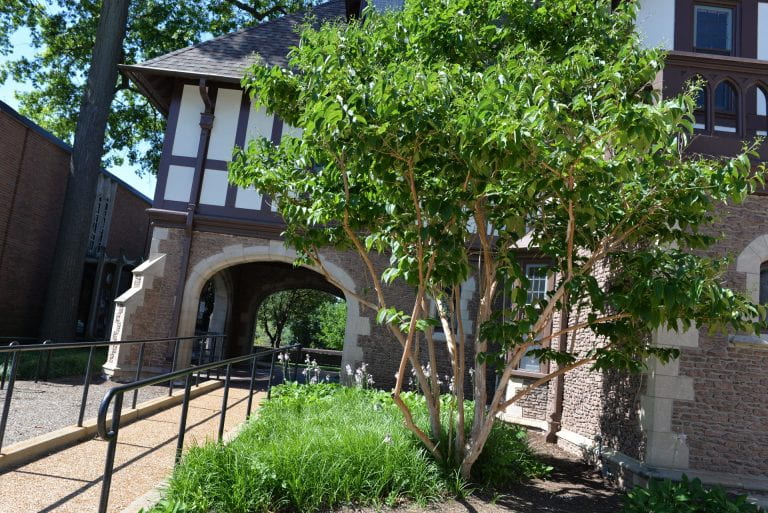
Seven-Son Flower
Arbor Walk #66, TreeKeeper ID #2585
The Seven-Son Flower is a large deciduous shrub with a fountain head that terminates in creamy white flower clusters. This plant is native to China, and provides a good source of nectar for butterflies.
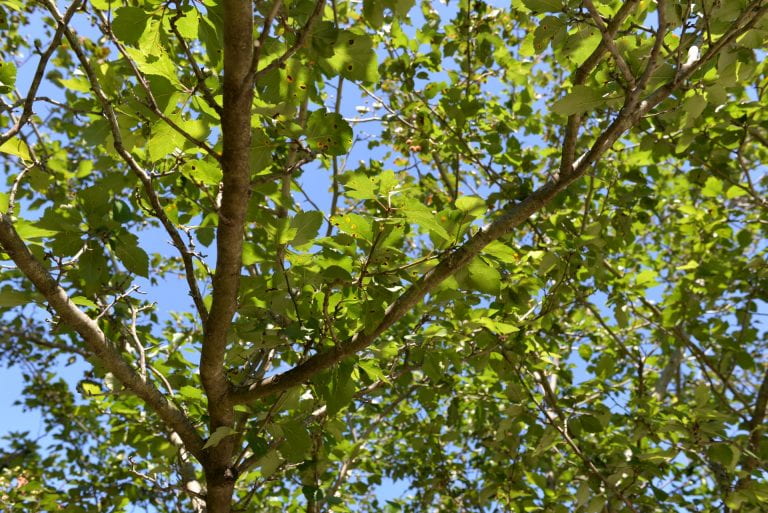
Downy Hawthorn
Arbor Walk #67, Treekeeper ID #1716
The Downy Hawthorn is a deciduous tree in the rose family, and is native to the Midwest. Despite the unpleasant scent and the presence of long thorns, the tree is much loved for the beauty of its flowers in the spring and fruits in the summer.
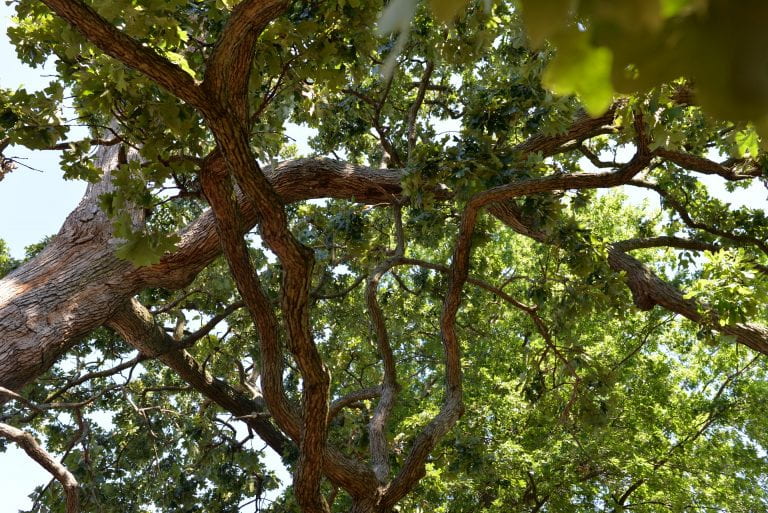
Post Oak
Arbor walk #68, TreeKeeper ID #2930
Post Oak is a North American species of oak in the white oak section. It is a slow-growing oak that lives in dry, poor soils, and is resistant to rot, fire, and drought.
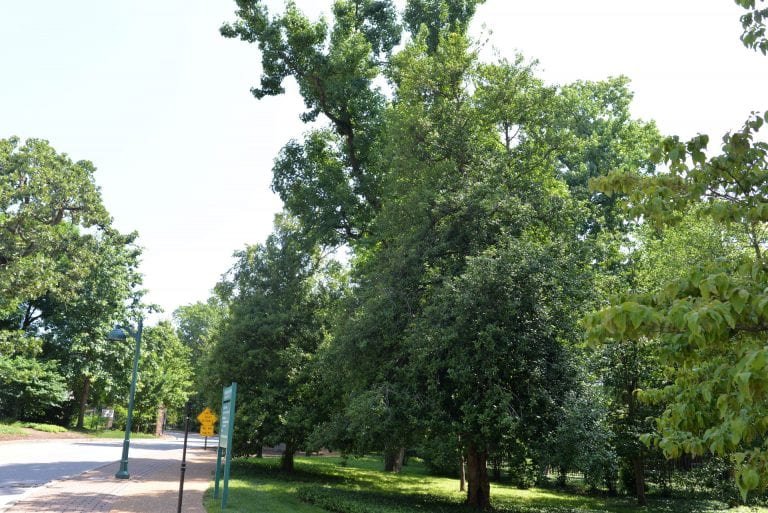
American Holly
Arbor Walk #69, Treekeeper ID #3034
The American Holly is a broad-leaved evergreen tree reaching 40 to 50 feet high, densely pyramidal in youth becoming more open and symmetrically conical with age.
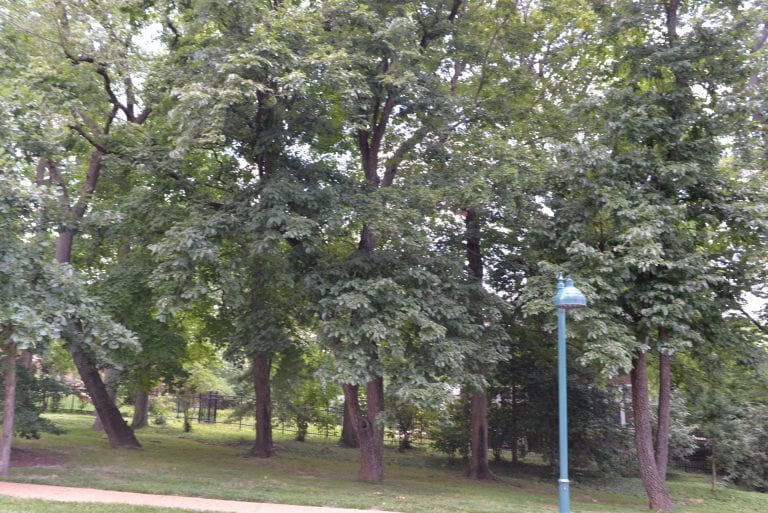
Persimmon
Arbor walk #70, TreeKeeper ID #3345
The Persimmon tree is native to the Southeastern U.S. and is easily recognized in winter by its unusual rugged, blocky bark.
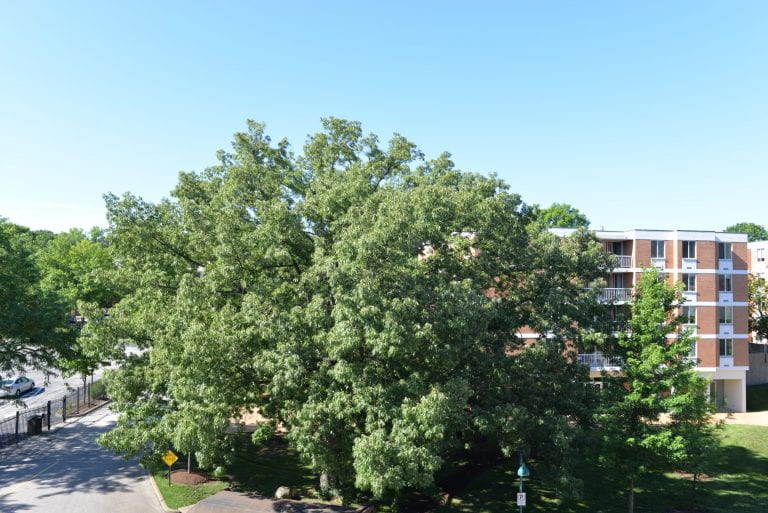
Cherrybark Oak
Arbor Walk #71, TreeKeeper ID #3472
Cherrybark Oak is a medium to large-sized deciduous tree native to the Southern US including the southeast corner of Missouri. The Cherrybark Oak looks very similar to another Missouri native, Southern Red Oak. So much so, that this tree was mislabeled as a Southern Red Oak for many years in the Arboretum.
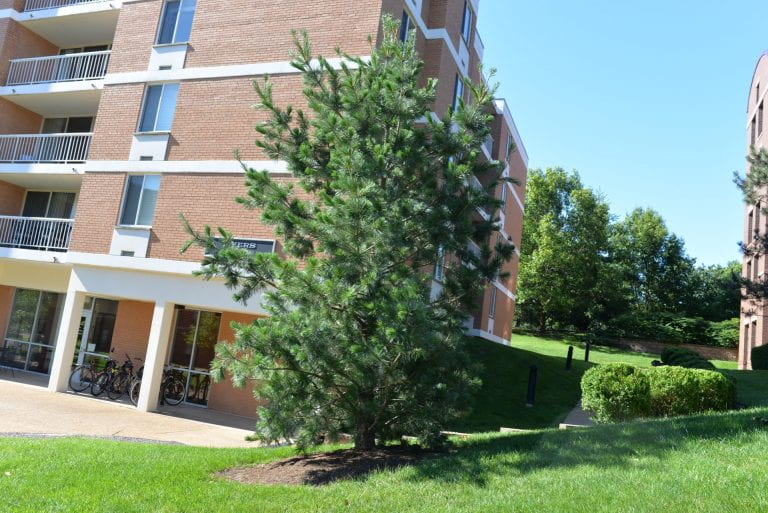
Limber Pine
Arbor walk #72, Treekeeper ID #3697
This under-used pine, native to the western United States, is more tolerant of alkaline soils than the Eastern white pine. The dark blue green needles help this tree stand out in the landscape.
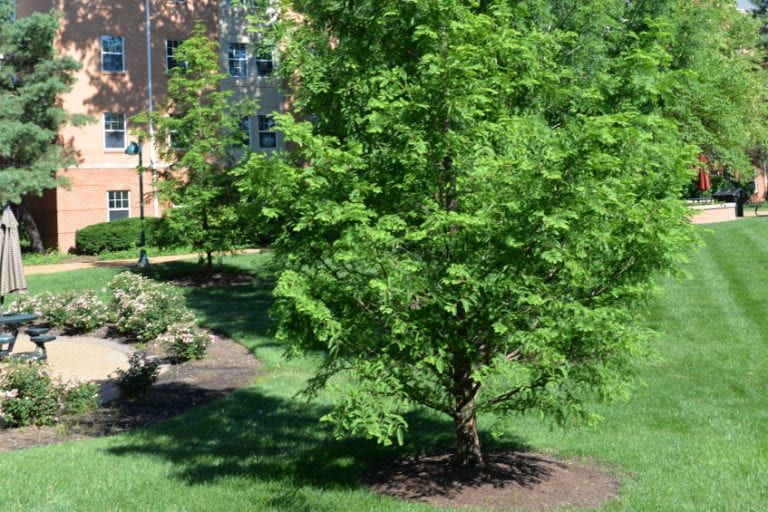
Dawn Redwood
Arbor Walk #73, Treekeeper ID #2196
The Dawn Redwood is considered a living fossil because it was only known due to the fossil remains from individuals that lived with the dinosaurs. It was not until the 1940’s that a small population was discovered in a remote valley of the Szechwan province of China.
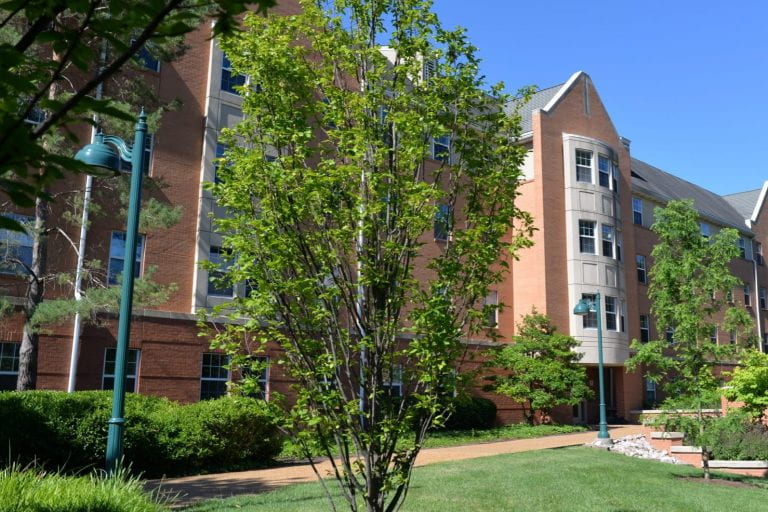
European Hornbeam
Arbor walk #74, Treekeeper ID #2259
This adaptive species is often grown as a shield or hedge plant in urban settings, as it grows a thick canopy that extends most of the way to the ground.
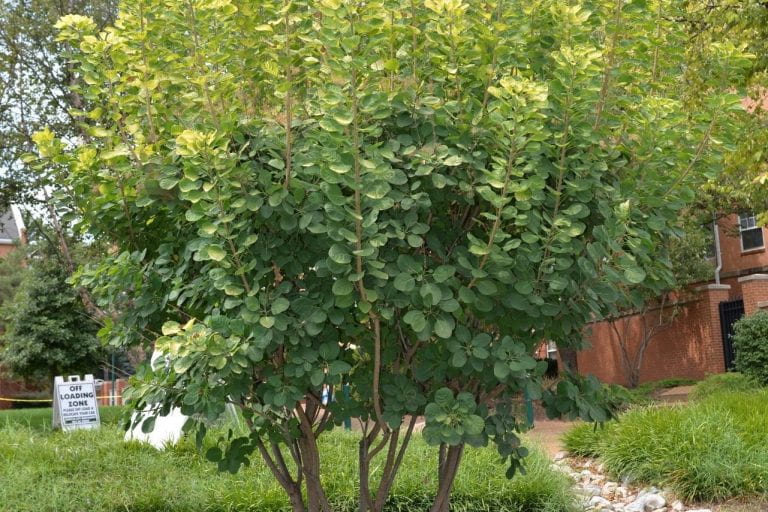
Smoke Tree
Arbor Walk #75, TreeKeeper ID #2753
This small 10-15 foot Eurasian tree is best known for the show it puts on annually; smoke trees produce pink to purple hair-like strands that emerge from its flowers each summer, appearing to be a “smoke” that covers the tree.
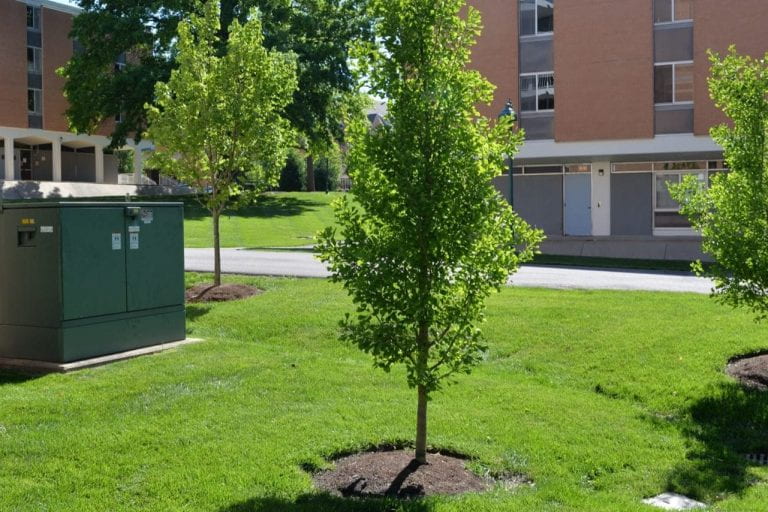
Ginkgo ‘Saratoga’
Arbor walk #76, Treekeeper ID #5991
This unique pest-resistant species originated in China and is the last species in its order Ginkgophyte, which was first found in fossils that dated back to the Permian period, 270 million years ago.
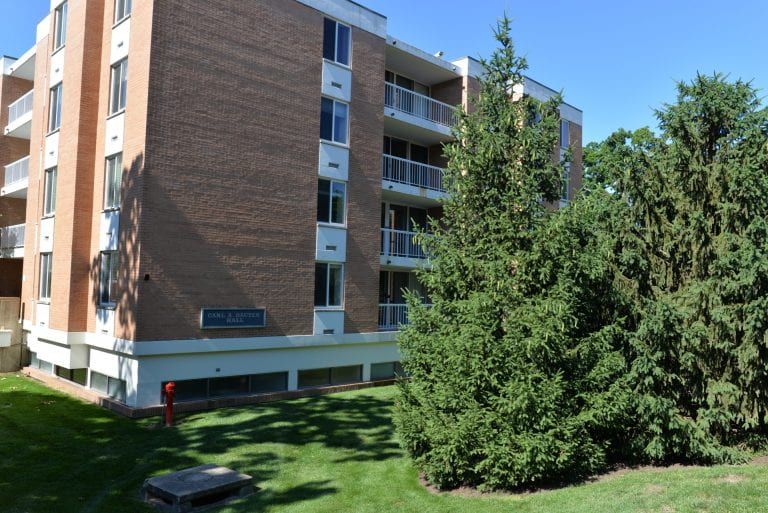
Norway Spruce
Arbor walk #77, TreeKeeper ID #2644
This European spruce is often planted in temperate regions of the United States as a wind blocker, as it can grow quickly and reach an average height of 60 feet in artificial habitats. The tree’s early branches are tilted upwards, but over time the branches adopt a more open and perpendicular stance.
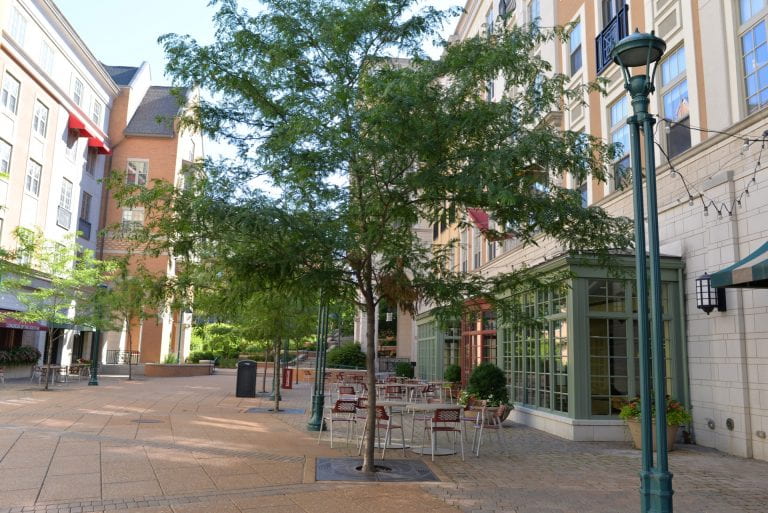
Common Thornless Honeylocust
Arbor Walk #78, Treekeeper ID #3229
The Honeylocust is a tough, medium-sized shade tree that usually grows around 60′ to 80′ tall. It has greenish-yellow to greenish-white flowers that appear in May or June.
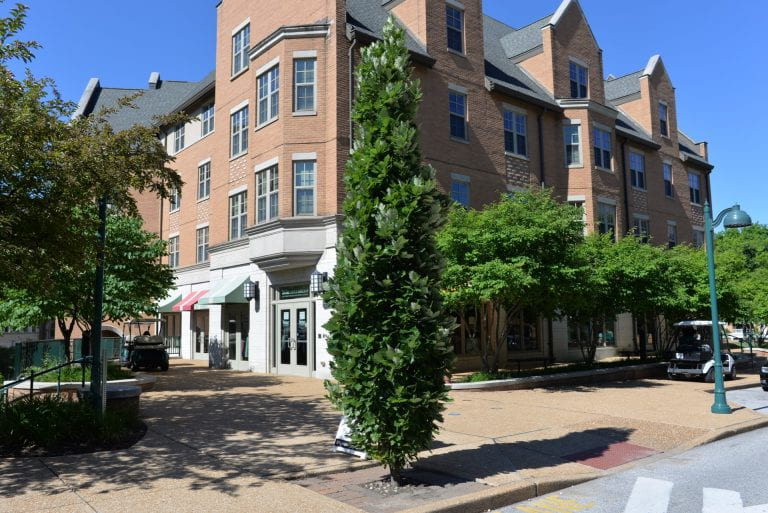
Ware’s Oak ‘Kindred Spirit’
Arbor Walk #79, TreeKeeper ID #2226
Selected from a batch of chance seedlings collected from the campus of University of Missouri Columbia, this cultivar is a cross between the English Oak and the Swamp White Oak. The tree grows to quite a large size with a distinct columnar form.
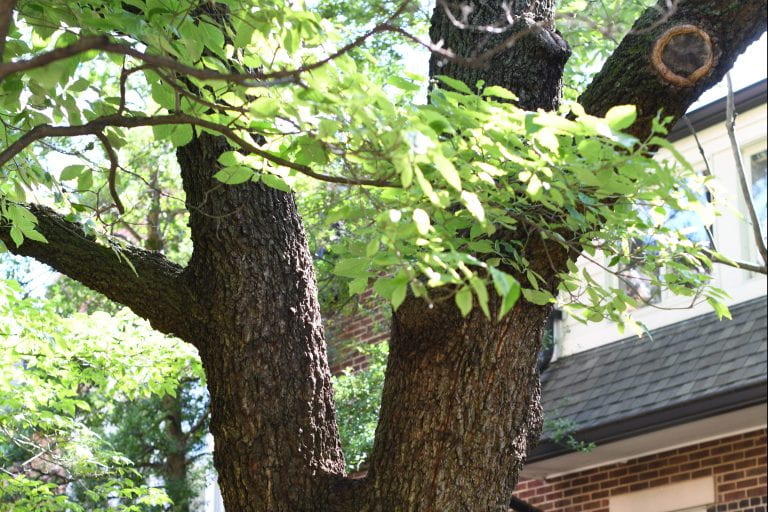
Sawtooth Oak
Arbor Walk #80, TreeKeeper ID #3239
The Sawtooth Oak is a medium sized deciduous tree, growing 40-60 feet tall with a broad-spreading, rounded crown. It is native to China, Korea and Japan and grows yellow-green flowers and oval acorns with spiny, scaly cups.
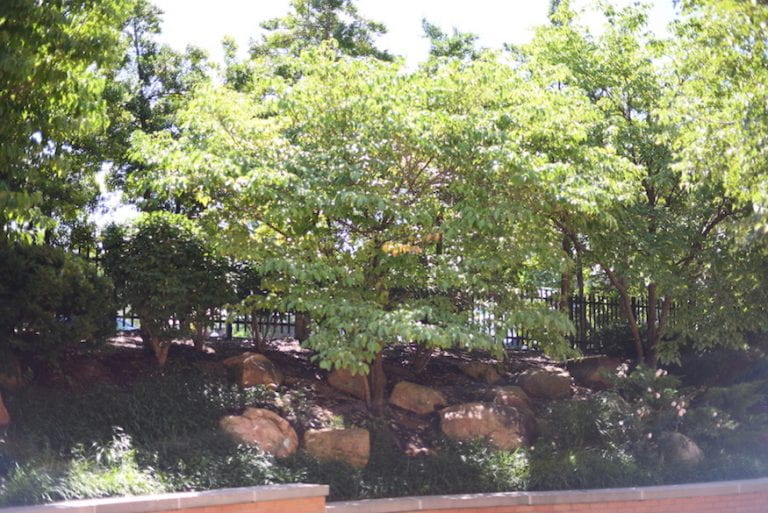
Flowering Dogwood
Arbor walk #81, Treekeeper ID #3692
This is a small, beautiful, adaptive, flowering tree, blooming in early spring. It has white flowers and oval dark green leaves which turn into shades of red in the fall and it grows bitter, inedible bright red fruits.
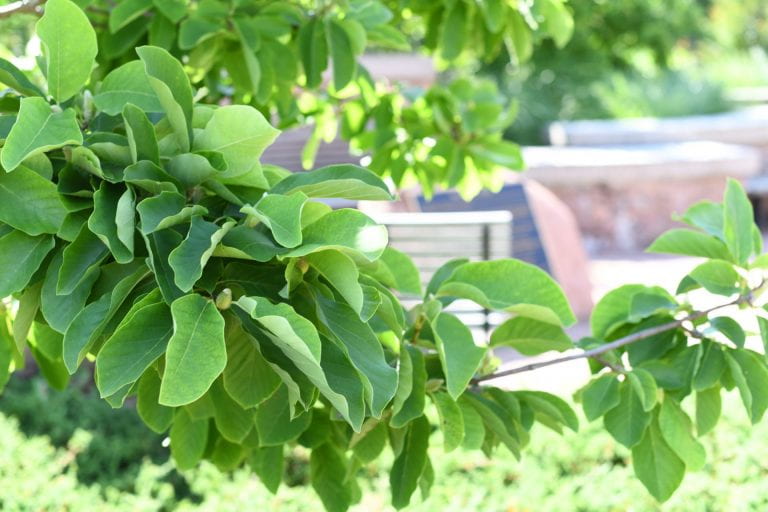
Hybrid Magnolia
Arbor walk #82, Treekeeper ID #3854
This is a deciduous hybrid magnolia resulting from a cross between M. acuminata and M. denudata. It is notable for its yellow flowers, late vegetative growth, compact pyramidal form, and ability to withstand both heat and cold.
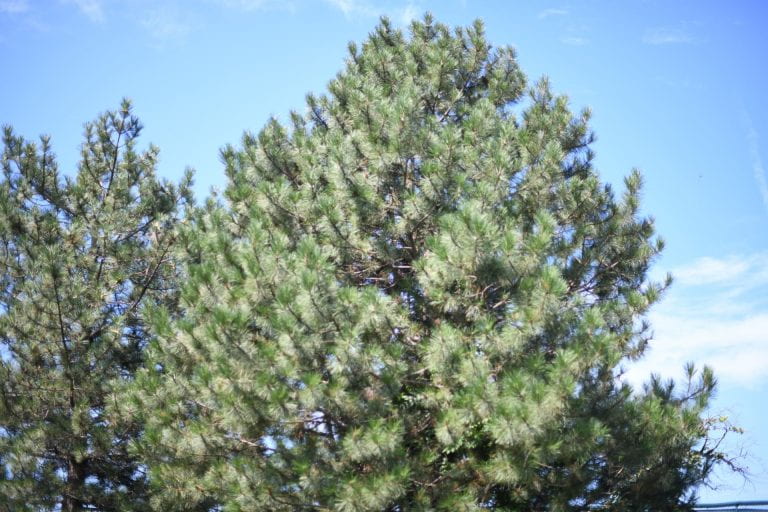
Austrian Pine
Arbor Walk #83, Treekeeper ID #3668
This is a medium to large conifer than is native to Europe and Asia. They are dense and pyramidal when young and round with age. These trees feature spreading branches, stiff, dark green needles in bundles, and oval cones.
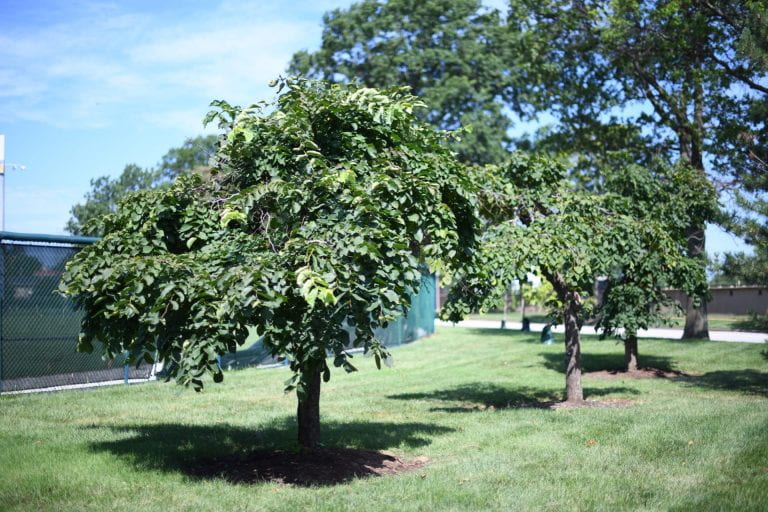
Scotch Elm
Arbor Walk #84, Treekeeper ID #3382
This cultivar of the Scotch Elm, known as the Camperdown Elm, is a large deciduous tree with a rounded crown and bowing, drooping branches. While the wild-type Scotch Elm may reach 70′-100′ in height, the Camperdown Elm will not grow above 30′ tall.
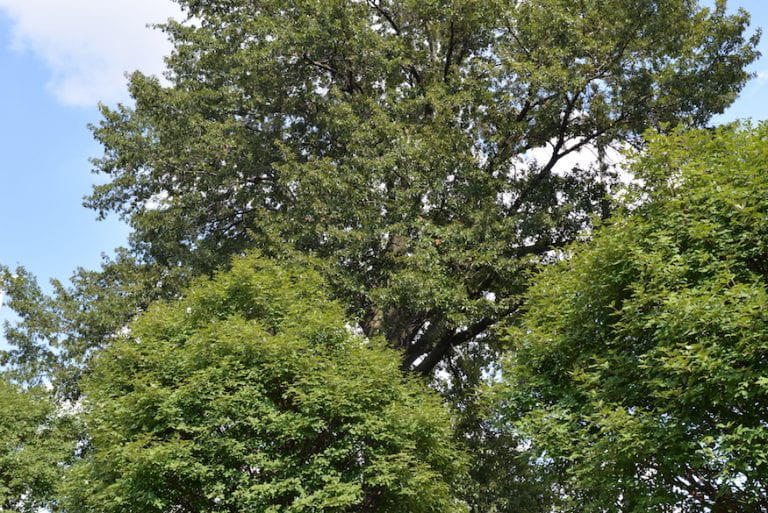
Shingle Oak
Arbor Walk #85, TreeKeeper ID #2263
This atypical oak lacks the normal lobed leaf structure seen in other oak species. Its common name derives from the fact that early settlers in the Midwest often used wood from the tree to shingle their roofs.
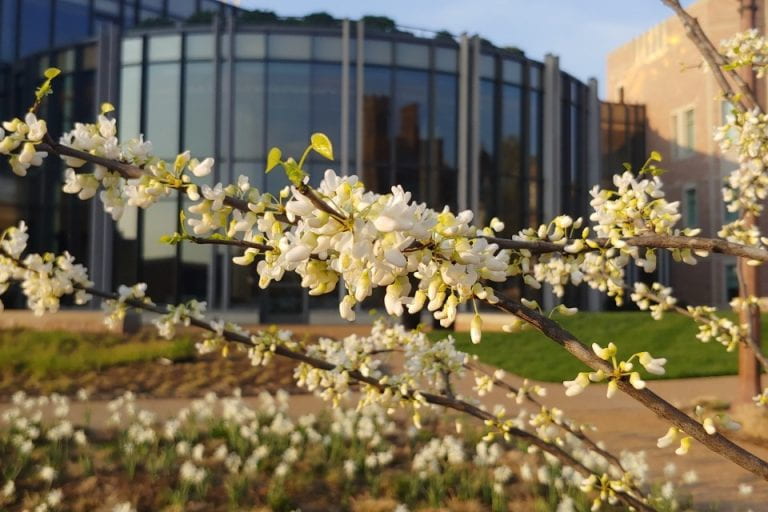
Eastern Redbud, White
Arbor Walk #86, Treekeeper ID #5725
White Bud is a native cultivar to the Missouri Area with heart-shaped leaves. Its parentage comes from the native Red Bud seen throughout Missouri.
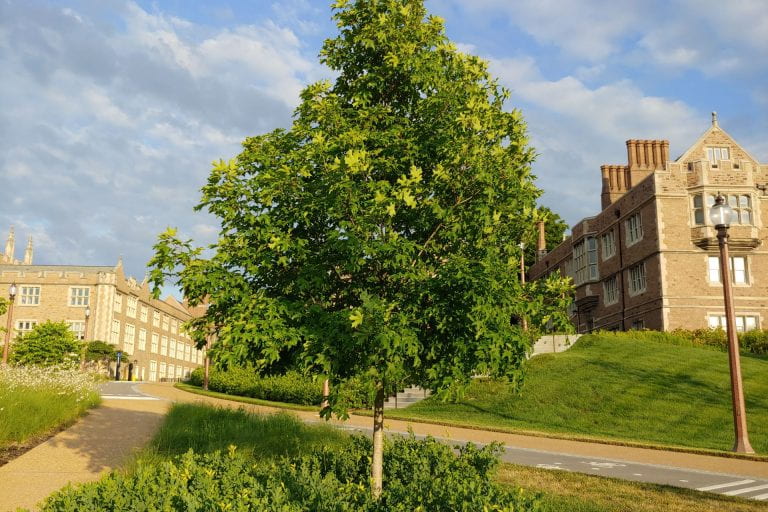
Sugar Maple
Arbor Walk #87, Treekeeper ID #5825
‘Bailsta’ is a cultivar of the Sugar Maple. It can grow to 50′ tall by 40′ wide, with a much wider, more rounded form than most Sugar Maples.
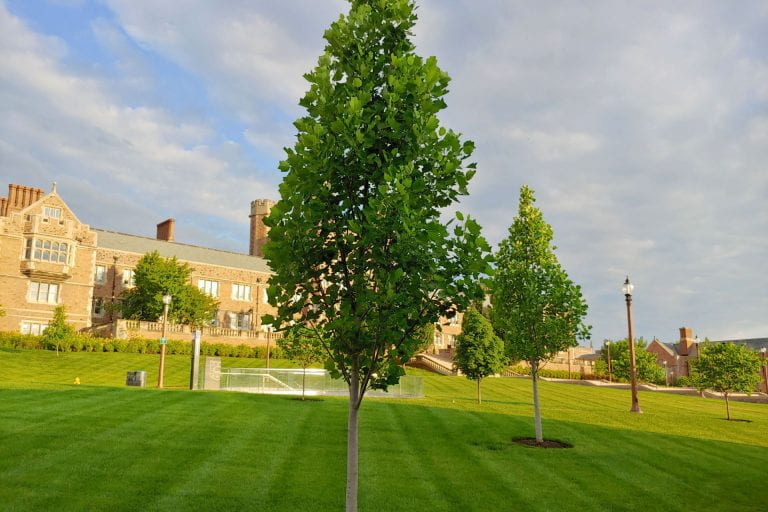
Tulip Tree
Arbor Walk #88, Treekeeper ID #5650
Emerald City® is a commercially developed cultivar of the Missouri native Tulip Tree. J. Frank Schmidt & Son Co. created the cultivar to be cold-tolerable and stand straight, making it suitable to city sized landscapes. The trees grow to be 55′ tall and 25′ wide. The foliage is an attractive glossy dark green. The trunk develops furrowed fissures as they reach maturity. Tree #88 was planted in a triad with two other Emerald City® Tulip trees.
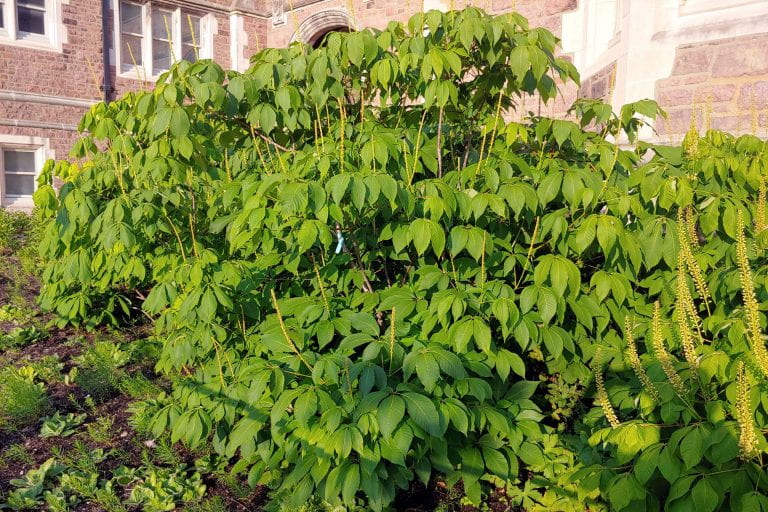
Bottlebrush Buckeye
Arbor Walk #89, TreeKeeper ID #8345
Bottlebrush Buckeye is not native to Missouri but is very adaptable to the St. Louis Region. It is a multiple stem understory small tree or large shrub which colonizes by suckering.
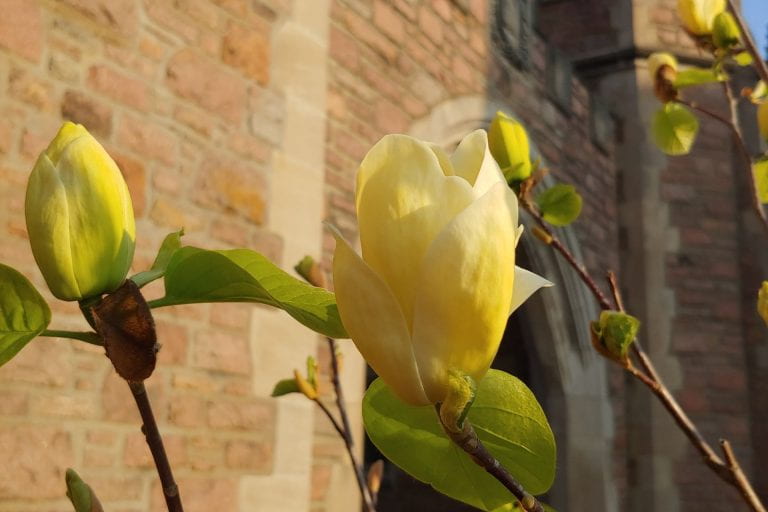
Hybrid ‘Lois’ Magnolia
Arbor walk #90, Treekeeper ID #5902
Magnolia ‘Lois’ is adaptive to the St. Louis region and was introduced in 1998 by the Brooklyn Botanical. It flowers in the Spring with a true pale yellow color and it grows to 30′ tall and 20′ wide.
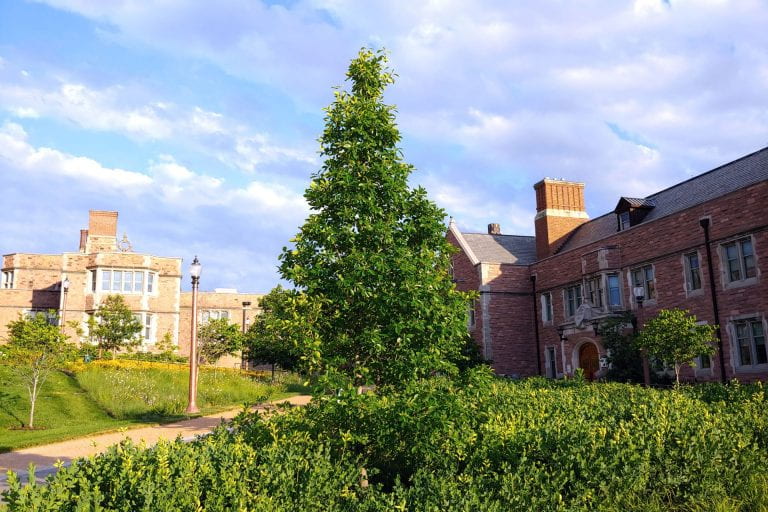
Black Gum
Arbor Walk #91, Treekeeper ID #5922
The Black Gum, also known regionally as Black Tupelo, is a part of the Nyssaceae family, which used to be under the dogwood family.
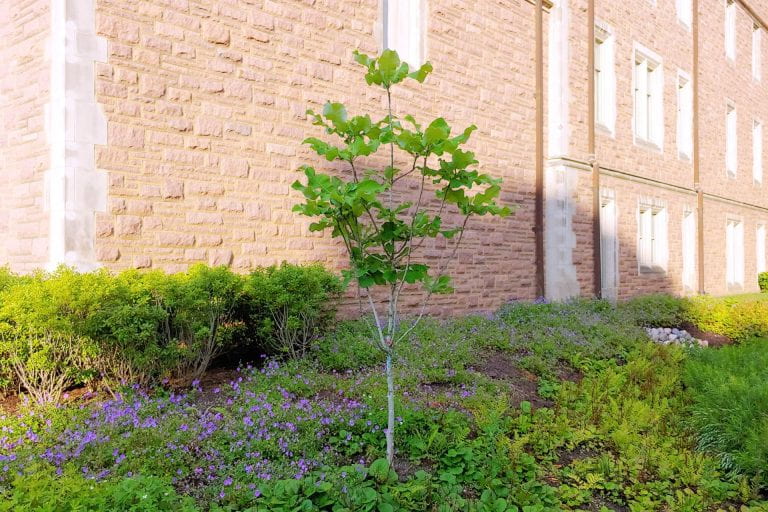
Ashe’s Magnolia
Arbor Walk #92, Treekeeper ID #4775
The Ashe’s Magnolia is a regional native to the Southeastern US and adaptable to the St. Louis Region, typically growing to 10’ to 20’ tall and 10’ to 15’ wide.
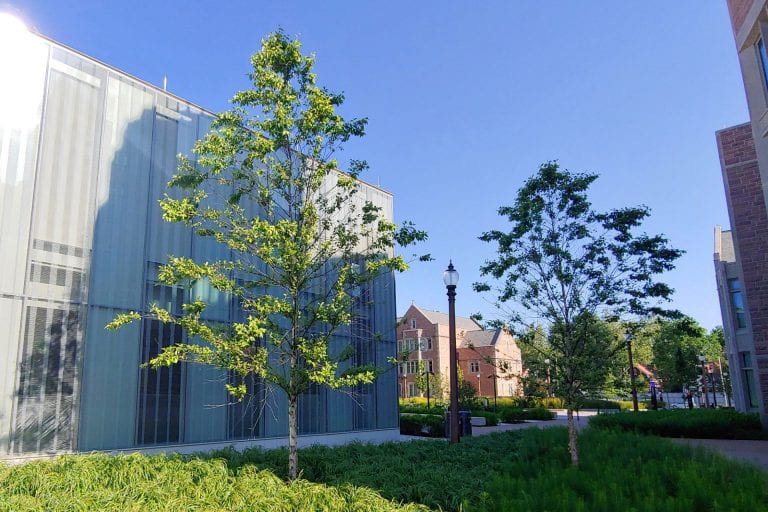
River Birch
Arbor walk #93, TreeKeeper ID #5649
A tree native to the Eastern and Midwestern United States, River Birch is also known as black birch. As a relatively heat resistant tree in the birch family, the river birch tree’s distribution extends further south than most other birch trees.
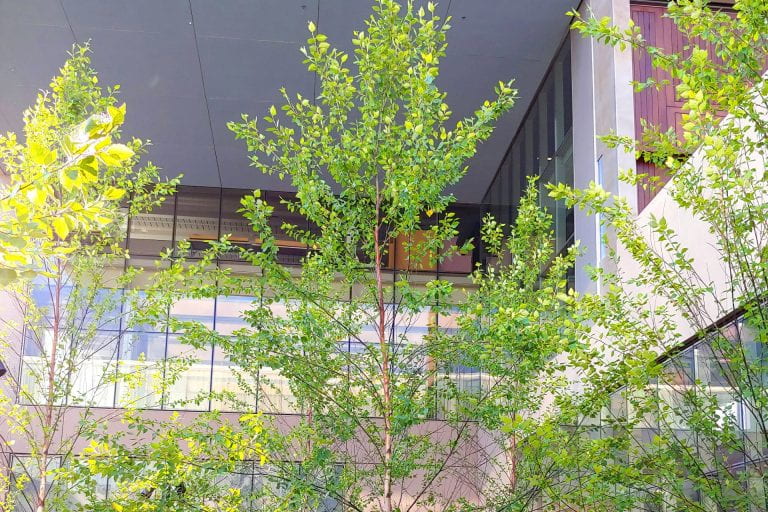
River Birch
Arbor Walk #94, TreeKeeper ID #5861
The ‘Cully’ cultivar of the River Birch was discovered in a St. Louis, Missouri suburb and introduced by Earl Cully, a well known arborist from Illinois. The ‘Cully’ grows 40’ tall and 40’ wide.
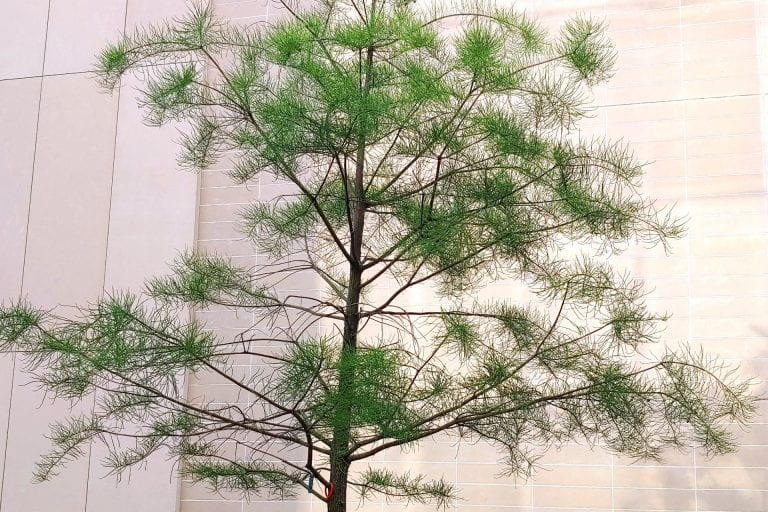
Pond Cypress
Arbor Walk #95, TreeKeeper ID #5772
Native to the southeastern U.S., the Pond Cypress is a member of the Taxodens genus. It has deeply furrowed barks and slender needles that emerge from erect shoots.
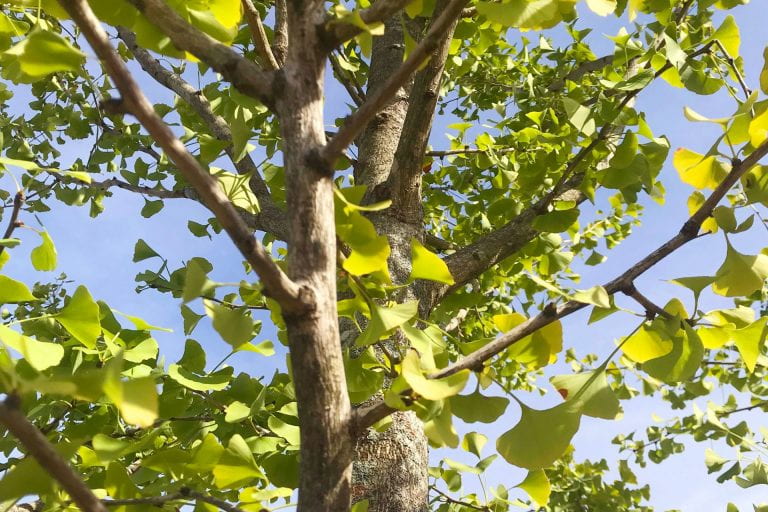
Ginkgo
Arbor walk #96, Treekeeper ID #5779
The ‘Autumn Gold’ evolved over 200 million years ago and can withstand extremely harsh conditions. The tree produces a beautiful gold leaf color in Autumn, hence the name.
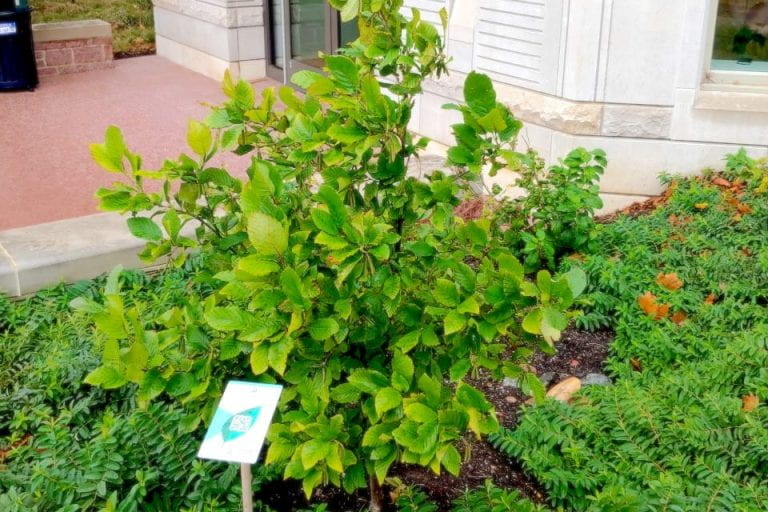
Hazel Alder
Arbor walk #97, Treekeeper ID #6102
Hazel Alder is a multi-stemmed small tree and can grow to 20′ high and up to 15′ wide forming thickets by suckering. It is native from Nova Scotia to Illinois and Missouri south to eastern Texas and northern Florida. It is an ideal selection for naturalizing or rain gardens.
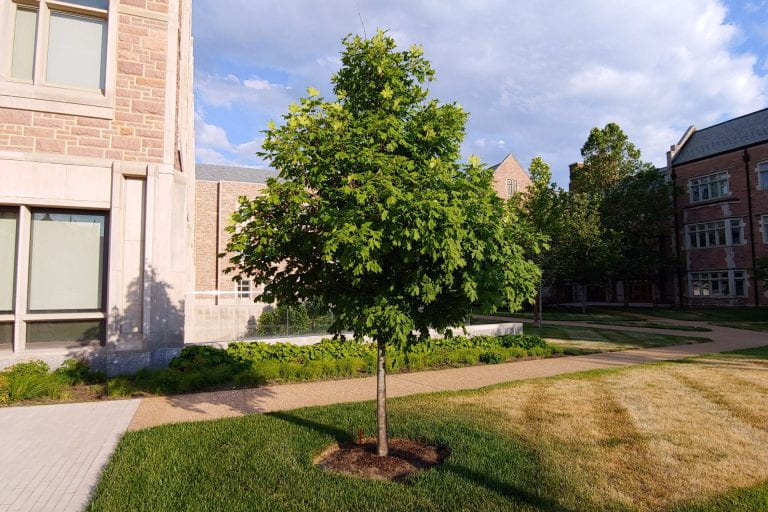
Sugar Maple ‘Caddo’
Arbor Walk #98, Treekeeper ID #5662
This tree is in the Sapindaceae family and is one of the easiest and strongest maples to grow. Caddo Maples are native to southwestern Oklahoma and are resistant to heat and drought.
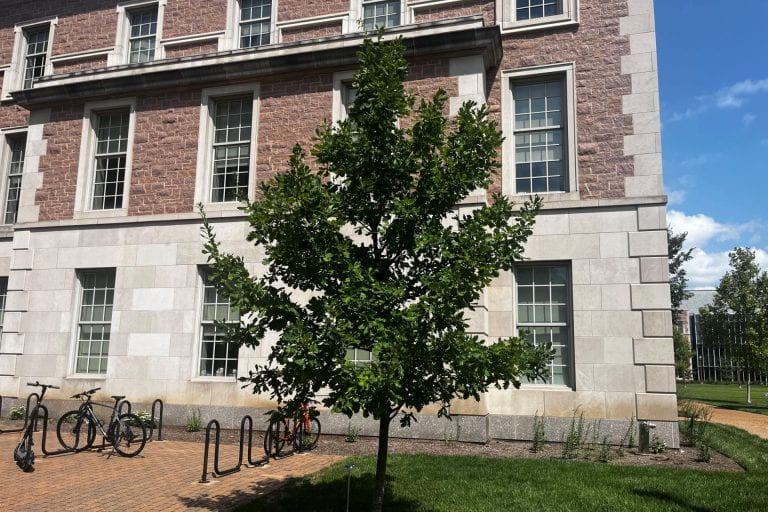
English Oak
Arbor Walk #99, Treekeeper ID #6570
English Oak is native and found in mixed woodland areas and planted widely in North America since the 1600s. It has long been a timber source in England.

Three-Flowered Maple
Arbor Walk #100, Treekeeper #6600
Three Flowered Maple is a small understory tree and grows to 30′ tall. Features of this tree include exfoliating bark and fall color of orange to red foliage.